We’ve had a bad case of the Jumbies the last few months. Jumbies are a kind of dark ghost that are part of Caribbean folk lore and are evidently at fault for all sorts of bad luck. Jumbies can shape shift and according to Miguel Browne, a local dialect poet and comedian, in the modern world they take the form of anything from a computer virus to politician.
The year didn’t start off badly, in fact it started off looking very promising. We had a lovely visit in Salt Lake and Seattle over Christmas. Shortly after we returned to Trinidad, Rich was offered a temporary position as senior lecturer (i.e. Assoc. Professor) in Chemistry at UWI. We had a nice new English family move in to the flat on our right and enjoyed watching Obama’s inauguration with our American neighbors to our left. We spent several evenings listening to the local steel pan bands preparing for the Carnival Panorama competition and enjoyed the political and social commentary at the Calypso tents. We went to hear the Extempo competition again this year and went in to Port of Spain for Tuesday’s Carnival parade.
It was at on Carnival Tuesday that our luck started turning for the worse. We drove in to Port of Spain around midday. Naturally many roads were closed for Carnival and so police were directing traffic around road blocks and toward parking areas. The police directed us to park “right there” and so we parked “right there” just as directed and walked in to town where we enjoyed several hours liming and watching the Mas (short for Mascarade) parade before returning to find our car gone. After staring for a bit in wide eyed disbelieve, the taxi drivers standing near by informed us that the police had been towing cars and gave us direction to the police station. So we walked the few blocks over to the police station, found our car and joined the long line of people who’d had their cars towed. When I got to the front of the line, I explained to the police that the police had instructed me to park “right there”. They told me “they mislead you”. Evidently they were Jumbies. We paid them our 100 TT$ (~16 US$) and they released the hostage so we could go home.
Three days latter (Friday), Rich got up at 5 am as usual to go for his morning ride and a few minutes later he called upstairs to ask me what I’d done with his wallet. Since I had no idea what he was talking about I got up and went down stairs at which point we discovered that the lock on our back porch had been removed. Our computers, back up drives, and a wide range of other small but extremely valuable items had been taken. The Jumbies had struck again.
We called the police and started pacing up and down the street of our gated community while it gradually sunk in that I had lost 5 years of my research work and several thousand dollars worth of stuff. We walked down the back of our row of town houses and noticed that 8 more of the town houses in our court had also been broken into. One by one the neighbors started coming into the court in shock. One of the first neighbors up is an under secretary at the Indian High Commission. It had been about an hour since I’d called the police but no one had come yet so he called the Indian High Commission who called the police who acknowledged that they had received my call and we had two detectives in our court within 5 minutes. There are advantages to having well connected neighbors.
I gave a statement to the detectives and then the crime lab came in a dusted for fingerprints. Since most of the neighborhood are employed by UWI, the UWI housing officer and security team came by next and then a reporter from the local paper came by. http://guardian.co.tt/news/crime/2009/02/28/uwi-professors-diplomats-robbed The story in the Trinidad paper is fairly accurate, except that our flats aren’t posh even by local standards. The car in that photo is ours and the pick-up truck belongs to a friend who’d come by to give us moral support, mango juice and cornbread.
The story evidently made the papers all over India. http://www.deccanherald.com/Content/Mar12009/scroll20090301121420.asp?section=scrollingnews. The report in the Deccan Harold is a bit further off the mark. We were the first people up in the neighborhood and. there were no strange smells or evidence of any type of sleeping gas. We heard rumors about gas being used in buglaries of this type but the police told us these stories are apocryphal and there is no evidence to suggest gas was used in this robbery or commonly in other robberies. This was pretty much what we expected as chemists since we woke up clear headed at 5 AM as usual. It is kind of astounding that the thieves were able to break into 9 flats on our block where people were home sleeping and no one woke up or heard anything. In retrospect, we are very lucky no one woke up since the robbers were armed and shootings are not uncommon in robberies here.
The most miraculously amazing part of this story is that the police actually caught the thieves and recovered many of the stolen items. We got back two laptop computers and one of my backup drives. Unfortunately, the Jumbies had deleted most of the documents from my computer and they were the items backed up on the hard drive that was not recovered. Still we were luckier than most of our neighbors whose hard drives had been completely reformatted. The hard drive I recovered was the one that contained all my irreplaceable data, for which I am deeply relieved and grateful. I’ve been able to recover some of my files using hard disk recovery software but I’m still discovering things I’ve lost, like the thousands of references in my endnote library. All in all, I have to say we were luckier than I had imagined we’d be in such an unlucky situation.
Wait, that’s not the end of the story. Two weeks after the robbery, while I was still talking with the police several times a day about recovering our stolen goods, Rich was mauled by a pack of 8 dogs while he out for his morning walk. While he was fighting off the smaller dogs with his stick from the front, the biggest dog came around back and sunk his teeth into Rich’s thigh just above the knee. The dog owners were near by and managed call off the dogs and take Rich to the hospital. I got a phone call from the doctor shortly after 7 am and went by the hospital to find Rich with a wound that was a couple inches long and went over an inch into his thigh muscle. They usually don’t stitch dog bites because of the risk of infection but this wound was so deep they decided they had to do some thing so they put in two sutures to kind of hold things together, bandaged the wound, gave us a boat load of antibiotics and some pain killers and told us to come back in the morning so they could check for infection. The wound was so severe that he was unable to walk or bend his leg at all for 3 weeks. Of course, he was back in at work that afternoon meeting with students and overseeing a lab. Rich would have to be unconscious before he’d miss working with his students and even then he’d feel deeply guilty when he regained consciousness.
For nearly 4 weeks Rich couldn’t ride his bike, swim or even walk more than a few feet. I drove him to work and even across campus when he needed to give a lecture. Those of you who know Rich know that this was shear agony and that had he not been both in severe pain and deeply worried about permanent damage to his leg there is no way he would have been able to convalesce that long. Luckily the boat load of antibiotics and brutal cleaning the nurse did on the wound were enough to prevent the wound from getting infected. As soon as the doctor removed the stitches and gave him permission, Rich was back to walking (or rather limping) to work. Within a week he was back out an his bike. Eight week later, he is not yet back to 100 percent and has some pain in the muscle when he rides, but he is back to doing all the things he normally does and we are hopeful that there won’t be any lasting damage besides the scars.
I wish I could say that was the last we’d seen of the Jumbies but the first weekend Rich was back on his feet we went out for a hike in the Chagaramas National Park. It was a lovely day, I saw a howler monkey and we sat up on a ridge watching leather back turtles swimming in the bay below. Unfortunately I came home with about a hundred chigger bites and Rich didn’t fare much better. Then there have been a serious of problems at the University that have made Rich’s job miserable and he got a nasty computer virus, on a Mac for all things, and my lab flooded once again so I’m still not able to move in to it and Rich has scrapes and bruises from the car that brushed him while he was on his bike Wednesday morning, and right now I’ve got a stack of reports and exams to grade that’s nearly a meter high (seriously). We haven’t tried walking into the house backwards or leaving knotted ropes at the door (two traditional ways to ward off Jumbies) but if things don’t improve soon we may.
Sunday, May 3, 2009
Friday, January 23, 2009
Thanksgiving Weekend in Tobago
Thanksgiving weekend in Trinidad and Tobago
We had decided a few weeks back that we would celebrate Thanksgiving by joining the Trinidad and Tobago Field Naturalist Club (TTFNC) on their annual outing to Tobago. Thanksgiving isn’t a holiday in Trinidad, it’s a regular work day. I had a night class Thursday so we hadn’t planned on doing anything to celebrate until the weekend. That night, Rich met me at my class around 8 pm and we walked home together. I’d left my car lights on Wednesday night, so the car battery was dead and we were hoping one of our neighbors would still be up and about so we could get some help jumpstarting the car. When we came through the gate, we found our community courtyard packed with cars. Our American neighbors had invited everyone they knew over for a Thanksgiving party. They not only nicely helped us get the car started; they then plied us with turkey and other tasty foods and drinks. We are definitely blessed with terrific neighbors.
After a hectic morning at work on Friday, I came home around 3 pm and we threw some gear into our bags hoping we hadn’t brought all the wrong stuff and headed to the airport to meet with our TTFNC friends. TTFNC usually takes the ferry to Tobago but one of the ferries is currently out of service and the other was booked up weeks in advance so we switched to plan B and flew. Shortly after 4 pm we loaded up the car and headed for the airport only to get stuck in gridlock traffic. One of the bridges on the highway was washed out in last week’s floods. It has been replaced with a temporary Bailey bridge, which is somewhat narrower than the original. This was enough to bring traffic to a dead standstill. It took us a full hour to go a little more than a mile from campus to the bridge. We arrived at the airport to find the trip organizer pacing and fretting about us as well as others who had not yet arrived. Luckily, he had planned for the group to meet two hours before the flight so although we were late for the rendezvous, we were still in plenty of time to easily make the flight.
It only takes 20 minutes to fly from Trinidad to Tobago and it took only a few minutes after landing to collect bags and pick up the rental cars. The Tobago airport is located at Crowne Point near the southwest tip of Tobago and we were headed to Charlotteville, which is as far from Crowne Point as you can get without leaving the island. Tobago is a just small island, but the roads are slow and winding so it took us a little over an hour to make our way up the Atlantic coast to the northeast end of the island. (Tobago is bordered by the Atlantic on its southeast side and the Caribbean on the northwest side). Unfortunately, it was long past sundown so we didn’t get much chance to see Tobago on the drive. After reaching Speyside where the road along the Atlantic coast ends, we crossed over to the Caribbean side on a steep winding road that must exceed a 20% grade at points and then dropped down into Charlotteville.
Charlotteville is a small fishing village located on Man of War Bay, which is one of the few natural deepwater ports in the region. The Atlantic conveyor belt splits around Tobago, which made the island an important strategic location for European sailing ships coming from Africa during the colonial era. The bay gained its name because it was one of the few bays deep enough for Man of War ships.
We stayed in the Man of War Bay Cottages http://www.man-o-warbaycottages.com/ which are located directly on the beach within a former cocoa estate that is now owned by the Turpin family and managed as a nature preserve. We stayed in a 3 bedroom cabin with 4 other field naturalists. Our cabin was located about 100 ft from the Caribbean Sea. We are told that Man of War Bay is usually very clear and calm, but weather was not in our favor. The sea was quite choppy, so we went to sleep to the sound of waves rolling onto the beach.
I woke up early and went out for a walk along the beach at sunrise. The skies were mostly cloudy but there were clear patches off to the north and a golden glow in the clouds as the sun came up. I saw a blue heron alongside one of the small streams that enter the bay and watched a few of the local fishermen heading out in their small boats. While I was out strolling on the beach, some of our TTFNC friends were watching two squirrels pick almonds off the trees near our cabins.
The plan was to leave at 8 am for a hike up Pigeon Hill, so after breakfast Rich and I decided to take a quick swim in the bay. The combination of rough water, recent hard rains and dredging efforts on the stream that comes into Charlotteville made the usually clear bay, quite brown and muddy. We are told that there are two small coral reefs right out in front of our cabins but the water was so murky that we quite literally couldn’t see our own hands in front of our faces.
While we were eating breakfast preparing for the morning hike, David Rooks, one of Tobago’s top naturalists and long time member of TTFNC came by to visit. His niece and a Dutch woman who is living in Charlotteville and doing research for her wild life management degree joined us on the hike. About the time we headed out for the hike, it started to rain steadily and 3 members of our group decided they’d rather go bird watching. The trail to Pigeon Hill starts just a hundred meters or so down from the turnoff to Flagstaff Hill, on the Charlotteville side. A red flower known as Deer Meat was growing right at the trailhead. While Dan, our hiking guide, was telling us how the plant was both edible and palatable, Rich, our environmental chemist, pointed out the nearby empty 55 gallon chemical drum and the white residue on the plants and suggested that perhaps eating these particular plants was unwise. The first section of the trail is an old dirt road and which had been recently cleared so it was in very good condition. After climbing easily for about a kilometer we reach a lovely viewpoint of Man of War Bay. There were two magnificent hardwoods growing near the viewpoint, a Caribbean Cedar (Cedral Oderata) and a Cyp. Not far past the viewpoint, Steven, our reptile guy, spotted a black and yellow snake known locally as Bahbelle Chenen (Leimadiphos melanatos neson) but it zipped off under the brush before the rest of us got a look at it. A bit further up the trail there is another viewpoint looking off toward Englishman’s Bay on the Atlantic side of the Island but by this time the storm clouds were thick enough that our view was of lovely mist rolling up the hillside rather than the sea below.
As we proceeded up the trail, the rain got progressively harder which wasn’t conducive to bird watching but did bring out a large number (we estimate at least 15) mountain crabs that were scurrying up and down the trail. After about 2 kilometers, the trail became more overgrown and Dan had to use his cutlass (Machete for you Yankees) in places to clear the way. Up higher the trail enters rain forest and we saw number of notable plants including Climbing Palm, Rubber Tree, and Tropical Stinging Nettle, which is a truly vicious plant. Aside from the fact that it stings, this plant bears no relation to the stinging nettle that grows in temperate regions.
Roughly an hour and a half into the hike, the trail met a large ravine rushing with water from the ongoing rain. Dan informed us that the trail had been rerouted up a steep hill and that it was no more than 10 minutes from where we stood to the top of Pigeon Hill. While we waited for some of the group members to catch up the hard rain turned to a genuine deluge. It was raining hard enough you could tip your head back and get a drink. That may be an exaggeration but only a very small one. We were holding out our cupped hands and in only a few seconds we’d have enough fresh rainwater to drink. One of our team members cut us all excellent hiking sticks while we waited and then, once again assured that it was only 10 minutes to the top we headed up the steep, muddy slippery hill. After an hour of climbing up the exceedingly steep muddy track that was rapidly turning into a cascade as the rain got even harder we finally reached the top of Pigeon Hill. We were rewarded on the climb by finding and catching a small purple and greenish clouded snake (Sibon nebulata nebulata) and seeing much beautiful rainforest vegetation.
The rain slowed as we descended the trail and a few birds began to come out. We spotted the usual corn birds and orange winged parrots and watched a male rufous-tailed Jacamar who was perched a few feet from the trail.
By the time we reached the road the rain had stopped and the clouds were starting to lift. David Rooks happened by on the road just as we exited the trailhead. While we were regaling Mr. Rooks with our adventures and regrouping we discovered a beautiful iridescent gold beetle that neither Mr. Rooks nor any of our experts recognized. We were all drenched to the skin and covered with mud from sliding down the steep trail sections so we walked back to our cabin and sent someone cleaner and drier back for the cars.
When we met up with the bird group, they informed us they needed to be renamed “the reptile group”. The hard rain wasn’t conducive to good bird watching but they did see a Boa Constrictor crossing the road. They reported that the deluge that had soaked us to the skin had caused considerable mayhem on the roads below. The river that comes into the Bay near Speyside was out of its banks and several sections of road were temporarily blocked by mud and rock slides.
Our plan had been to spend the afternoon snorkeling but the hard rains had filled the bays with a great deal of silt and the water was very murky so we enjoyed a walk around Charlotteville and a meal of fresh caught kingfish and chips. Toward evening, the clouds lifted and we went up Flagstaff Hill for a view of the island and then scouted out the roads that had been flooded earlier in the day. That night, Mr. Rooks and Mrs. Turpin joined us in the cabin and shared tales of natural history of Tobago, shark fishing and pirate hangings in Pirates Bay.
The next morning, the weather was much clearer and so we went off to snorkel in Pirates Bay. During the night the water had mostly cleared so we were able to see the brain coral and plenty plenty fish including the queen angel fish, the french angel fish, several types of parrot fish and many others whose names I really need to learn.
After a lovely morning of snorkeling and sand, most of our group went in to Speyside for lunch. Since this was our first trip to Tobago, Rich and I decided we’d rather spend our time outside so we went up Flagstaff Hill to enjoy the view and then walked back to the cabins to meet up with the rest of the club by midafternoon. We drove the scenic route down the Caribbean side of the island back and arrived in Crowne Point in time to watch the sunset from the beach before our plane ride back to Trinidad.
We had decided a few weeks back that we would celebrate Thanksgiving by joining the Trinidad and Tobago Field Naturalist Club (TTFNC) on their annual outing to Tobago. Thanksgiving isn’t a holiday in Trinidad, it’s a regular work day. I had a night class Thursday so we hadn’t planned on doing anything to celebrate until the weekend. That night, Rich met me at my class around 8 pm and we walked home together. I’d left my car lights on Wednesday night, so the car battery was dead and we were hoping one of our neighbors would still be up and about so we could get some help jumpstarting the car. When we came through the gate, we found our community courtyard packed with cars. Our American neighbors had invited everyone they knew over for a Thanksgiving party. They not only nicely helped us get the car started; they then plied us with turkey and other tasty foods and drinks. We are definitely blessed with terrific neighbors.
After a hectic morning at work on Friday, I came home around 3 pm and we threw some gear into our bags hoping we hadn’t brought all the wrong stuff and headed to the airport to meet with our TTFNC friends. TTFNC usually takes the ferry to Tobago but one of the ferries is currently out of service and the other was booked up weeks in advance so we switched to plan B and flew. Shortly after 4 pm we loaded up the car and headed for the airport only to get stuck in gridlock traffic. One of the bridges on the highway was washed out in last week’s floods. It has been replaced with a temporary Bailey bridge, which is somewhat narrower than the original. This was enough to bring traffic to a dead standstill. It took us a full hour to go a little more than a mile from campus to the bridge. We arrived at the airport to find the trip organizer pacing and fretting about us as well as others who had not yet arrived. Luckily, he had planned for the group to meet two hours before the flight so although we were late for the rendezvous, we were still in plenty of time to easily make the flight.
It only takes 20 minutes to fly from Trinidad to Tobago and it took only a few minutes after landing to collect bags and pick up the rental cars. The Tobago airport is located at Crowne Point near the southwest tip of Tobago and we were headed to Charlotteville, which is as far from Crowne Point as you can get without leaving the island. Tobago is a just small island, but the roads are slow and winding so it took us a little over an hour to make our way up the Atlantic coast to the northeast end of the island. (Tobago is bordered by the Atlantic on its southeast side and the Caribbean on the northwest side). Unfortunately, it was long past sundown so we didn’t get much chance to see Tobago on the drive. After reaching Speyside where the road along the Atlantic coast ends, we crossed over to the Caribbean side on a steep winding road that must exceed a 20% grade at points and then dropped down into Charlotteville.
Charlotteville is a small fishing village located on Man of War Bay, which is one of the few natural deepwater ports in the region. The Atlantic conveyor belt splits around Tobago, which made the island an important strategic location for European sailing ships coming from Africa during the colonial era. The bay gained its name because it was one of the few bays deep enough for Man of War ships.
We stayed in the Man of War Bay Cottages http://www.man-o-warbaycottages.com/ which are located directly on the beach within a former cocoa estate that is now owned by the Turpin family and managed as a nature preserve. We stayed in a 3 bedroom cabin with 4 other field naturalists. Our cabin was located about 100 ft from the Caribbean Sea. We are told that Man of War Bay is usually very clear and calm, but weather was not in our favor. The sea was quite choppy, so we went to sleep to the sound of waves rolling onto the beach.
I woke up early and went out for a walk along the beach at sunrise. The skies were mostly cloudy but there were clear patches off to the north and a golden glow in the clouds as the sun came up. I saw a blue heron alongside one of the small streams that enter the bay and watched a few of the local fishermen heading out in their small boats. While I was out strolling on the beach, some of our TTFNC friends were watching two squirrels pick almonds off the trees near our cabins.
The plan was to leave at 8 am for a hike up Pigeon Hill, so after breakfast Rich and I decided to take a quick swim in the bay. The combination of rough water, recent hard rains and dredging efforts on the stream that comes into Charlotteville made the usually clear bay, quite brown and muddy. We are told that there are two small coral reefs right out in front of our cabins but the water was so murky that we quite literally couldn’t see our own hands in front of our faces.
While we were eating breakfast preparing for the morning hike, David Rooks, one of Tobago’s top naturalists and long time member of TTFNC came by to visit. His niece and a Dutch woman who is living in Charlotteville and doing research for her wild life management degree joined us on the hike. About the time we headed out for the hike, it started to rain steadily and 3 members of our group decided they’d rather go bird watching. The trail to Pigeon Hill starts just a hundred meters or so down from the turnoff to Flagstaff Hill, on the Charlotteville side. A red flower known as Deer Meat was growing right at the trailhead. While Dan, our hiking guide, was telling us how the plant was both edible and palatable, Rich, our environmental chemist, pointed out the nearby empty 55 gallon chemical drum and the white residue on the plants and suggested that perhaps eating these particular plants was unwise. The first section of the trail is an old dirt road and which had been recently cleared so it was in very good condition. After climbing easily for about a kilometer we reach a lovely viewpoint of Man of War Bay. There were two magnificent hardwoods growing near the viewpoint, a Caribbean Cedar (Cedral Oderata) and a Cyp. Not far past the viewpoint, Steven, our reptile guy, spotted a black and yellow snake known locally as Bahbelle Chenen (Leimadiphos melanatos neson) but it zipped off under the brush before the rest of us got a look at it. A bit further up the trail there is another viewpoint looking off toward Englishman’s Bay on the Atlantic side of the Island but by this time the storm clouds were thick enough that our view was of lovely mist rolling up the hillside rather than the sea below.
As we proceeded up the trail, the rain got progressively harder which wasn’t conducive to bird watching but did bring out a large number (we estimate at least 15) mountain crabs that were scurrying up and down the trail. After about 2 kilometers, the trail became more overgrown and Dan had to use his cutlass (Machete for you Yankees) in places to clear the way. Up higher the trail enters rain forest and we saw number of notable plants including Climbing Palm, Rubber Tree, and Tropical Stinging Nettle, which is a truly vicious plant. Aside from the fact that it stings, this plant bears no relation to the stinging nettle that grows in temperate regions.
Roughly an hour and a half into the hike, the trail met a large ravine rushing with water from the ongoing rain. Dan informed us that the trail had been rerouted up a steep hill and that it was no more than 10 minutes from where we stood to the top of Pigeon Hill. While we waited for some of the group members to catch up the hard rain turned to a genuine deluge. It was raining hard enough you could tip your head back and get a drink. That may be an exaggeration but only a very small one. We were holding out our cupped hands and in only a few seconds we’d have enough fresh rainwater to drink. One of our team members cut us all excellent hiking sticks while we waited and then, once again assured that it was only 10 minutes to the top we headed up the steep, muddy slippery hill. After an hour of climbing up the exceedingly steep muddy track that was rapidly turning into a cascade as the rain got even harder we finally reached the top of Pigeon Hill. We were rewarded on the climb by finding and catching a small purple and greenish clouded snake (Sibon nebulata nebulata) and seeing much beautiful rainforest vegetation.
The rain slowed as we descended the trail and a few birds began to come out. We spotted the usual corn birds and orange winged parrots and watched a male rufous-tailed Jacamar who was perched a few feet from the trail.
By the time we reached the road the rain had stopped and the clouds were starting to lift. David Rooks happened by on the road just as we exited the trailhead. While we were regaling Mr. Rooks with our adventures and regrouping we discovered a beautiful iridescent gold beetle that neither Mr. Rooks nor any of our experts recognized. We were all drenched to the skin and covered with mud from sliding down the steep trail sections so we walked back to our cabin and sent someone cleaner and drier back for the cars.
When we met up with the bird group, they informed us they needed to be renamed “the reptile group”. The hard rain wasn’t conducive to good bird watching but they did see a Boa Constrictor crossing the road. They reported that the deluge that had soaked us to the skin had caused considerable mayhem on the roads below. The river that comes into the Bay near Speyside was out of its banks and several sections of road were temporarily blocked by mud and rock slides.
Our plan had been to spend the afternoon snorkeling but the hard rains had filled the bays with a great deal of silt and the water was very murky so we enjoyed a walk around Charlotteville and a meal of fresh caught kingfish and chips. Toward evening, the clouds lifted and we went up Flagstaff Hill for a view of the island and then scouted out the roads that had been flooded earlier in the day. That night, Mr. Rooks and Mrs. Turpin joined us in the cabin and shared tales of natural history of Tobago, shark fishing and pirate hangings in Pirates Bay.
The next morning, the weather was much clearer and so we went off to snorkel in Pirates Bay. During the night the water had mostly cleared so we were able to see the brain coral and plenty plenty fish including the queen angel fish, the french angel fish, several types of parrot fish and many others whose names I really need to learn.
After a lovely morning of snorkeling and sand, most of our group went in to Speyside for lunch. Since this was our first trip to Tobago, Rich and I decided we’d rather spend our time outside so we went up Flagstaff Hill to enjoy the view and then walked back to the cabins to meet up with the rest of the club by midafternoon. We drove the scenic route down the Caribbean side of the island back and arrived in Crowne Point in time to watch the sunset from the beach before our plane ride back to Trinidad.
Monday, November 24, 2008
Update: Eid, Divali, Diversity and Life
It strikes me that we have not commented to this blog in some time, partly at least due to Bonnie’s camera being non-functional. I rather like the pictorial accompaniment, but perhaps I can download relevant photos. We have enjoyed several holidays covering our three major religions (Hindu, Christian, Islam) and a bit of paganism as well. We had a nice Divali. I went to the UWI celebration, which featured singing, dancing, pretty girls in saris, and a skit of Rama and Hanuman rescuing Sita. On Divali itself our Hindu neighbors put out lots of lights, both the official oil candles and electric. The electric lights have stayed up as we approach Christmas, and Santa Claus, sleighs and reindeer are now occupying rooftops. Another recent holiday was Eid, the end of Ramadan. I went to the campus celebration, which also had a skit. This one was about a student whose lax fasting practices served a bad example to his little brother. Happily, he repented of his lax behaviour and all ended well. The celebration also included music and singing (shouldn’t they all?), a slideshow about Ramadan for non-Muslims, and a keynote lecture about the universality of Islam. This lecture was well presented and refreshing to hear, since the American and European media are always going on about bad things respecting Islam. The fact is that a billion Muslims find significant value in their faith.

The new American kids in our neighbourhood announced that Halloween would be celebrated so we would need candy. We obliged, and they decorated and there were lots of properly costumed guests who came for the festivities. Halloween is not a T & T holiday, but Carnival costumes are well understood! Superheroes, witches, and princesses dominated as usual. The hostess dressed as Obama girl. As Bonnie has reported, our neighbours of all nationalities are Obama supporters, and chants of O-ba-ma have been coming from kids irrespective of citizenship. The Obama festivities of course culminated in Election Day. I tried to watch the returns on the TV but couldn’t deal with them, so I followed the internet until giving that up when it was already after bedtime. When one gets up at 5 AM bedtime is early. The results were manifested when there was much rejoicing about 11 PM or thereabouts. Bonnie and I were very surprised to find that our absentee votes mattered! Salt Lake, after the absentee ballots were counted, had a majority for Obama. Cheerily, Bozeman also went Obama. My voting decision was less clearcut than Bonnie’s. At heart, I felt that I should vote for my Party, and go Green and vote for Cynthia. Or I should vote for Ralph, the man who has supported my values for decades. The Utah ballot even gave me a Socialist option. However, I ended up joining my peers in the solid ex-pat Obama block.
Rainy season continues. On the bright side, that means slightly lower temperatures. Not a lot, since that means lows of about 75 F and highs of 91 F, but it is noticeable and a great relief for me. I still ride in the early morning so as to get back before traffic becomes intolerable, and now the days have shortened enough to need a headlight. As a tropical area, we still have roughly 12 hours of light even this time of year. The evenings have been pleasant over the last month. At about 5:30 PM the sun goes down, and promptly the mosquito- eating birds swoop about (go birds!). They are followed by the bats (go bats!), after which the fireflies come out. By 6:15 or 6:30 the show ends with the fireflies rising to the top of the trees. They look like green meteors as the light shoots briefly overhead. The other aspect of rainy season, which just started again as evidenced by the sound of the tin roof, is of course rain, and T & T has experienced some significant flooding. Over the last week my riding has been primarily on the highways, due to said floods. Last week the Tacarigua River overflowed in the Caura Valley, where I often ride, and deposited considerable mud and rocks on the road. The upper valley had water still flowing across the road, deeper than the tires on my single speed mountain bike. So I decided to skip Caura to give the river time to return to its banks and the fine CEPEP workers (CEPEP are hired by the government to do cleanup and other environment /civil work, and we routinely exchange greetings as I ride by) time to clean up the road. Too bad, because Caura is quite pretty. The trees in the mountain rain forest are very green, the river sparkles and there are lots of flowers. The pomerac trees have been particularly nice. The blossoms are a very deep pink and the roads have been adorned with pinkness. This morning I finally rode Caura again and was cheerily surprised at what good shape the road was in. Lots of work from CEPEP, no doubt. Thanks!

(Sidenote: Drat, more mosquitoes biting me. I have repellent on, but it sweats off too fast. Yes, even sitting at the computer, I regret to say. The fan (without which life is unpleasant) helps blow the damnable things away from my legs, but only helps. Long clothes add to the heat problem. We have not worked out an acceptable solution to the heat/mosquito issue. When we get too frustrated we hide under the bed net, but I’m a little too hyper to stay there all day.)
Back to riding. I have been going of late on the Churchill Highway, and on the way outbound before sunrise there are flocks of white egrets flying across the green canefields and the building rain-clouds are nicely tinted (and encourage a brisk pace). The return is less pleasant, as the noise, tension and pollution levels soar from the commuter traffic. On Sunday mornings more people sleep in (or don’t drive, in any case) and the highways are nicer. Yesterday I quick ate a bowl of rice and went to 6 AM Mass, so I could get out while the getting was fair and get back hopefully before the rains. The plan was to ride south to Chaguanas, about 40 km round trip. I got there after the market was open, so Chaguanas Main was full of street stalls, shoppers and merchandise . I walked down Main and goggled at the hub-bub, but it was too uproarious for me to lock up my bike and shop. Besides, it was Sunday. As I rode out of town to the east, I was surprised to see a group of jersey-clad cyclists heading my way, splitting the lanes between dead stopped motor traffic in classic Critical Mass mode. I think I have commented before on how useful urban cycling skills are here in T&T. Anyways, I naturally spun around and joined them, riding at speed in between the cars, and turning onto the Solomon Hochoy highway south. I enjoyed riding with the group, but after about 10 km succumbed again from the singlespeed effect. This effect only occurs when riding on the flats with a group of roadies. I can usually keep up on climbs, as long as they aren’t terribly steep, and coast along on downs. With a 2X1 gear, I can spin along easily at about 25 or 30 kph but around maybe 35 kph I am spun out and there can be no further increase in velocity. So once again there came a point where the group increased speed and I could not follow. Several other riders came off shortly afterwards and I almost made it up to them before we topped a rise, but alas not and I was on my own. This is a familiar situation for me. As typically, I continued following the group, because if we came to a proper hill or someone flatted I could well catch on again, but it was not to be. I kept going anyway and turned around at San Fernando, 50 km away from home and rather further than I’d intended. So by the time I arrived home the heat of the day was well advanced, I was well hot and dry, and I much appreciated the cold Caribs in the refrigerator. Our water was even on, so I could get a shower!
Today is going well. I got a nice ride this morning, and as I said the road in Caura was much improved, and though I threw my chain by going through a big bump while pedaling fast I got it back on without difficulty. It is raining merrily so I don’t need to water the plants, but we haven’t lost electricity. I picked up a Bodi bake, for lunch, at a stand on the way back (fry bread with green beans inside, much better than it may sound) because I had to be home for the plumber. He does not make appointments, so during our frequent plumbing problems I have to sit here and wait for him to eventually come. The latest failure came last week in the floods. The water was cut off, as happens pretty much every week, but came back with such force that I could hear the air hissing as it blew out the seal in the back tap. Umm. So that has been running for days, wasting water and making noise since it couldn’t be turned off, but the tap is now replaced and mercifully silent. Hooray!
Saturday did not go as well. We loaded up the kayak and went to Williams Bay, and as usual being in Bonnie’s car made me very uptight. We made it there without incident, except for my uptight behaviour, off-loaded the boat, and Bonnie practiced stern paddling while I continued being uptight. I was antsy to get going before the winds picked up, so we got into our regular position (me stern, Bonnie bow) and paddled to 5 Islands. There we had very much the high point of the day, coinciding with high tide. As we have for the last several Saturday activities, we strapped the kayak to a tree, made sure our gear was well attached to the kayak, and went snorkeling. We had a great snorkel. It was early enough so we had good visibility, and we saw lots of fish and snorkeled until our lips hurt. We watched pelicans dive bombing fish while paddling the 2 miles back, had a cheery chat with the secretary of the kayak club, strapped the kayak onto the roofrack and headed for home in plenty of time for Bonnie to make it to her review at UWI. Yes, it was Saturday. University professorship is a lifestyle, after all. But anyway, all sounds good, right, until as we drove down the highway there came the loud sound of the roof rack ripping off and launching backwards onto the road, with our kayak attached. So that put rather a damper on the day. Fortunately, people here are used to cars coming to a sudden screeching halt right in front of them and no one hit us or were hit by our suddenly airborne kayak and chunks of rack. The so-called rack disintegrated in action. Poor design meant that the metal struts were attached to the roof with plastic brackets, which broke. So we put the poor kayak in the median while Bonnie moved the car off the road and I picked up various pieces. We strapped the kayak to the roof and went home. Our sad kayak has lots of scrapes and gouges, the bow carry handle and and stern tie-down were torn off, but it looks like the hull is intact. We hope so.
Ok, back to work. The eccentric bottom bracket on my bike is slipping, so the chain comes loose. Not something easily fixed in T&T, so I may to disassemble it and get some parts when we are next overseas. Global trade, right?

The new American kids in our neighbourhood announced that Halloween would be celebrated so we would need candy. We obliged, and they decorated and there were lots of properly costumed guests who came for the festivities. Halloween is not a T & T holiday, but Carnival costumes are well understood! Superheroes, witches, and princesses dominated as usual. The hostess dressed as Obama girl. As Bonnie has reported, our neighbours of all nationalities are Obama supporters, and chants of O-ba-ma have been coming from kids irrespective of citizenship. The Obama festivities of course culminated in Election Day. I tried to watch the returns on the TV but couldn’t deal with them, so I followed the internet until giving that up when it was already after bedtime. When one gets up at 5 AM bedtime is early. The results were manifested when there was much rejoicing about 11 PM or thereabouts. Bonnie and I were very surprised to find that our absentee votes mattered! Salt Lake, after the absentee ballots were counted, had a majority for Obama. Cheerily, Bozeman also went Obama. My voting decision was less clearcut than Bonnie’s. At heart, I felt that I should vote for my Party, and go Green and vote for Cynthia. Or I should vote for Ralph, the man who has supported my values for decades. The Utah ballot even gave me a Socialist option. However, I ended up joining my peers in the solid ex-pat Obama block.
Rainy season continues. On the bright side, that means slightly lower temperatures. Not a lot, since that means lows of about 75 F and highs of 91 F, but it is noticeable and a great relief for me. I still ride in the early morning so as to get back before traffic becomes intolerable, and now the days have shortened enough to need a headlight. As a tropical area, we still have roughly 12 hours of light even this time of year. The evenings have been pleasant over the last month. At about 5:30 PM the sun goes down, and promptly the mosquito- eating birds swoop about (go birds!). They are followed by the bats (go bats!), after which the fireflies come out. By 6:15 or 6:30 the show ends with the fireflies rising to the top of the trees. They look like green meteors as the light shoots briefly overhead. The other aspect of rainy season, which just started again as evidenced by the sound of the tin roof, is of course rain, and T & T has experienced some significant flooding. Over the last week my riding has been primarily on the highways, due to said floods. Last week the Tacarigua River overflowed in the Caura Valley, where I often ride, and deposited considerable mud and rocks on the road. The upper valley had water still flowing across the road, deeper than the tires on my single speed mountain bike. So I decided to skip Caura to give the river time to return to its banks and the fine CEPEP workers (CEPEP are hired by the government to do cleanup and other environment /civil work, and we routinely exchange greetings as I ride by) time to clean up the road. Too bad, because Caura is quite pretty. The trees in the mountain rain forest are very green, the river sparkles and there are lots of flowers. The pomerac trees have been particularly nice. The blossoms are a very deep pink and the roads have been adorned with pinkness. This morning I finally rode Caura again and was cheerily surprised at what good shape the road was in. Lots of work from CEPEP, no doubt. Thanks!

(Sidenote: Drat, more mosquitoes biting me. I have repellent on, but it sweats off too fast. Yes, even sitting at the computer, I regret to say. The fan (without which life is unpleasant) helps blow the damnable things away from my legs, but only helps. Long clothes add to the heat problem. We have not worked out an acceptable solution to the heat/mosquito issue. When we get too frustrated we hide under the bed net, but I’m a little too hyper to stay there all day.)
Back to riding. I have been going of late on the Churchill Highway, and on the way outbound before sunrise there are flocks of white egrets flying across the green canefields and the building rain-clouds are nicely tinted (and encourage a brisk pace). The return is less pleasant, as the noise, tension and pollution levels soar from the commuter traffic. On Sunday mornings more people sleep in (or don’t drive, in any case) and the highways are nicer. Yesterday I quick ate a bowl of rice and went to 6 AM Mass, so I could get out while the getting was fair and get back hopefully before the rains. The plan was to ride south to Chaguanas, about 40 km round trip. I got there after the market was open, so Chaguanas Main was full of street stalls, shoppers and merchandise . I walked down Main and goggled at the hub-bub, but it was too uproarious for me to lock up my bike and shop. Besides, it was Sunday. As I rode out of town to the east, I was surprised to see a group of jersey-clad cyclists heading my way, splitting the lanes between dead stopped motor traffic in classic Critical Mass mode. I think I have commented before on how useful urban cycling skills are here in T&T. Anyways, I naturally spun around and joined them, riding at speed in between the cars, and turning onto the Solomon Hochoy highway south. I enjoyed riding with the group, but after about 10 km succumbed again from the singlespeed effect. This effect only occurs when riding on the flats with a group of roadies. I can usually keep up on climbs, as long as they aren’t terribly steep, and coast along on downs. With a 2X1 gear, I can spin along easily at about 25 or 30 kph but around maybe 35 kph I am spun out and there can be no further increase in velocity. So once again there came a point where the group increased speed and I could not follow. Several other riders came off shortly afterwards and I almost made it up to them before we topped a rise, but alas not and I was on my own. This is a familiar situation for me. As typically, I continued following the group, because if we came to a proper hill or someone flatted I could well catch on again, but it was not to be. I kept going anyway and turned around at San Fernando, 50 km away from home and rather further than I’d intended. So by the time I arrived home the heat of the day was well advanced, I was well hot and dry, and I much appreciated the cold Caribs in the refrigerator. Our water was even on, so I could get a shower!
Today is going well. I got a nice ride this morning, and as I said the road in Caura was much improved, and though I threw my chain by going through a big bump while pedaling fast I got it back on without difficulty. It is raining merrily so I don’t need to water the plants, but we haven’t lost electricity. I picked up a Bodi bake, for lunch, at a stand on the way back (fry bread with green beans inside, much better than it may sound) because I had to be home for the plumber. He does not make appointments, so during our frequent plumbing problems I have to sit here and wait for him to eventually come. The latest failure came last week in the floods. The water was cut off, as happens pretty much every week, but came back with such force that I could hear the air hissing as it blew out the seal in the back tap. Umm. So that has been running for days, wasting water and making noise since it couldn’t be turned off, but the tap is now replaced and mercifully silent. Hooray!
Saturday did not go as well. We loaded up the kayak and went to Williams Bay, and as usual being in Bonnie’s car made me very uptight. We made it there without incident, except for my uptight behaviour, off-loaded the boat, and Bonnie practiced stern paddling while I continued being uptight. I was antsy to get going before the winds picked up, so we got into our regular position (me stern, Bonnie bow) and paddled to 5 Islands. There we had very much the high point of the day, coinciding with high tide. As we have for the last several Saturday activities, we strapped the kayak to a tree, made sure our gear was well attached to the kayak, and went snorkeling. We had a great snorkel. It was early enough so we had good visibility, and we saw lots of fish and snorkeled until our lips hurt. We watched pelicans dive bombing fish while paddling the 2 miles back, had a cheery chat with the secretary of the kayak club, strapped the kayak onto the roofrack and headed for home in plenty of time for Bonnie to make it to her review at UWI. Yes, it was Saturday. University professorship is a lifestyle, after all. But anyway, all sounds good, right, until as we drove down the highway there came the loud sound of the roof rack ripping off and launching backwards onto the road, with our kayak attached. So that put rather a damper on the day. Fortunately, people here are used to cars coming to a sudden screeching halt right in front of them and no one hit us or were hit by our suddenly airborne kayak and chunks of rack. The so-called rack disintegrated in action. Poor design meant that the metal struts were attached to the roof with plastic brackets, which broke. So we put the poor kayak in the median while Bonnie moved the car off the road and I picked up various pieces. We strapped the kayak to the roof and went home. Our sad kayak has lots of scrapes and gouges, the bow carry handle and and stern tie-down were torn off, but it looks like the hull is intact. We hope so.
Ok, back to work. The eccentric bottom bracket on my bike is slipping, so the chain comes loose. Not something easily fixed in T&T, so I may to disassemble it and get some parts when we are next overseas. Global trade, right?
Wednesday, November 5, 2008
Views of the US Election from Afar
I'm living in Trinidad and Tobago, a small island nation that is 1600 miles south east of Miami, Florida, the nearest city in The States, and only 7 miles from Venezuela. Since I moved here last December, I’ve been making a concerted effort to learn about the history and culture of this place. Sadly, slavery, oppression, imperialism and racial discrimination are central parts of that history and in many ways people here are still struggling to overcome that terrible legacy. Virtually every person in this country can trace their ancestry to either slaves or indentured laborers. White people, like me, make up less than one percent of the population so I have been learning a bit of what it is like to be a member of a tiny but highly visible minority.
I have lived most of my life in the western United States, in communities that were overwhelmingly white. Although I was taught by my parents from my youngest days to respect people of all races, my contact with people of African descent has been very limited. In the mid-1960’s when I was 3 years old my family moved from Utah to rural Pennsylvania. This was 1965, the year of Bloody Sunday in Alabama and race riots in Watts but I knew nothing of such things until I was much older. When we went to Philadelphia and saw black people on the streets (probably for the first time in my life), I remember my mother telling me that even though they looked different they were just regular people like us and we should be nice to them. I remember her giving us similar instructions a few years later when one of my Father’s black colleagues came to stay in our home.
In my Utah high school class of over 800, there were only 2 black students, one of whom, Linda Edwards, was a good friend. Sadly, I’ve completely lost touch with her over the years. In 9th grade, Linda and I were chosen to represent our school in a regional speech competition on the theme “My obligation to perpetuate freedom”. My parents attended the awards program for the regional competition where Linda placed first and I took second. We both gave our speeches as part of the program and I remember my father commenting on how moving it was to hear a black person talk about freedom.
Still, my contact with black people before I moved to Trinidad was very limited; they were anomalies in the communities in which I lived. I believe I can count the black people who I knew well during the first 45 years of my life on my fingers. In the 16 years I taught engineering in the US, I can remember only 1 black student who was in my classes. Through my church, which had an official policy of discrimination until 1978, I had only known a handful of blacks.
And so this past 10 months being immersed in the West Indian culture which has been molded by African, South Asian as well as European peoples has been an interesting personal voyage of exploration. As I interact daily with people whose ancestors come from every corner of the earth, I have been forced to recognize and repent of some deeply buried racial prejudices I never knew I held. I’ve been forced to deal with being continually and easily recognized as a foreigner and outsider because of the color of my skin and hair. Through this experience and my studies, I have gained a much greater insight into how deeply and broadly the lives of many people of color continue to be influenced by the crimes of the past 400 years.
In this context, I have followed the US Presidential election with a new perspective. I have anxiously read commentaries from the US on racial issues. Obama’s autobiography, which explores racial issues he faced as a child and young man, related very directly to the experiences I was having. I began to see connections I hadn’t seen before, in particular connections between the part of the world where I’m now living and black communities and racial problems in the US.
But even more than that, as I’ve lived in a truly international environment and associated daily with people from every continent in the world it has been increasingly evident to me how badly the US image in the world has been degraded over the past 7 years. When Obama secured the Democratic nomination last spring, there was an opinion piece printed in the local newspaper. The writer noted that there are two sides to America, a beautiful side that affirmed the ideals of human rights, equality and opportunity and an ugly side of imperialist aggression, racism, exploitation and hypocrisy. The writer noted that during recent years it had been difficult to remember anything but the ugly side; however, the nomination of Barack Obama stood as a reminder of America’s better virtues. Obama’s success was evidence that the American Dream was not dead, that a poor black child who started life with little more than a loving mother and devoted grandparents could indeed rise above those beginnings and aspire to the highest office. This Trinidadian columnist found in Barack Obama’s candidacy hope that America could rise above her recent problems and in that, he saw hope for the world at large.
I live in a neighborhood filled with professors and lecturers who teach at the University. It’s a very cosmopolitan neighborhood with people from Africa, India, Europe and the Americas. Two doors down there is a family from the D.C. area, the Mom teaches in Communications, the Dad is doing business consulting and they have a son who is 7 and a daughter who is 4. They are black.
Since the states switched off daylight time, we are one hour later here than the East Coast of the USA. So when I returned from teaching my night class last night shortly after 9 pm local, election results were just starting to come in. The first results were from hardcore Republican strongholds and our stomachs began to tighten as we remembered the disappointments of the last two Presidential election cycles. We turned off the TV and went to bed thinking the election would not likely be decided before our usual rising time of 5 am.
But two doors down, our neighbors were filled with hope and glued to the news. As we tossed in our bed worrying, we would periodically hear cheers from down the street. Shortly after midnight, the party erupted out on to the streets. Mixed with the voices of the adults was that of the 7 year old boy who I’d helped rescue a frog a few days back. He was singing out at the top of his lungs “President Obama”, “President Obama”.
And in that moment, I understood, in a way I would not have fully understood last year, exactly what this moment meant to African Americans and all those who have been down trodden, oppressed and disenfranchised. And in that moment I remembered “America the Beautiful”, built by patriots who dared not only to dream of a better future but also to work to make it a reality. And in that moment for the first time in years, I was proud of my country.
And while I am no longer naive enough to believe that this election will somehow erase all the horrid legacy of slavery and the disease of racism that still plagues segments of American society, it is proof that progress has been made, proof we can change; that we can improve and that our dreams of an America of alabaster cities undimmed by human tears can be realized. It awakes in me the hope that the day will come when “this nation (and the world) will rise up and live out the true meaning of its creed: 'We hold these truths to be self-evident, that all men are created equal” and where all people “will not be judged by the color of their skin, but by the content of their character.”
And I hope that no matter what your political persuasion, that you will be able to see beyond the partisan issues and appreciate the progress we have made as a people and a nation in my lifetime and join with me in feeling proud of America, at least for today.
I have lived most of my life in the western United States, in communities that were overwhelmingly white. Although I was taught by my parents from my youngest days to respect people of all races, my contact with people of African descent has been very limited. In the mid-1960’s when I was 3 years old my family moved from Utah to rural Pennsylvania. This was 1965, the year of Bloody Sunday in Alabama and race riots in Watts but I knew nothing of such things until I was much older. When we went to Philadelphia and saw black people on the streets (probably for the first time in my life), I remember my mother telling me that even though they looked different they were just regular people like us and we should be nice to them. I remember her giving us similar instructions a few years later when one of my Father’s black colleagues came to stay in our home.
In my Utah high school class of over 800, there were only 2 black students, one of whom, Linda Edwards, was a good friend. Sadly, I’ve completely lost touch with her over the years. In 9th grade, Linda and I were chosen to represent our school in a regional speech competition on the theme “My obligation to perpetuate freedom”. My parents attended the awards program for the regional competition where Linda placed first and I took second. We both gave our speeches as part of the program and I remember my father commenting on how moving it was to hear a black person talk about freedom.
Still, my contact with black people before I moved to Trinidad was very limited; they were anomalies in the communities in which I lived. I believe I can count the black people who I knew well during the first 45 years of my life on my fingers. In the 16 years I taught engineering in the US, I can remember only 1 black student who was in my classes. Through my church, which had an official policy of discrimination until 1978, I had only known a handful of blacks.
And so this past 10 months being immersed in the West Indian culture which has been molded by African, South Asian as well as European peoples has been an interesting personal voyage of exploration. As I interact daily with people whose ancestors come from every corner of the earth, I have been forced to recognize and repent of some deeply buried racial prejudices I never knew I held. I’ve been forced to deal with being continually and easily recognized as a foreigner and outsider because of the color of my skin and hair. Through this experience and my studies, I have gained a much greater insight into how deeply and broadly the lives of many people of color continue to be influenced by the crimes of the past 400 years.
In this context, I have followed the US Presidential election with a new perspective. I have anxiously read commentaries from the US on racial issues. Obama’s autobiography, which explores racial issues he faced as a child and young man, related very directly to the experiences I was having. I began to see connections I hadn’t seen before, in particular connections between the part of the world where I’m now living and black communities and racial problems in the US.
But even more than that, as I’ve lived in a truly international environment and associated daily with people from every continent in the world it has been increasingly evident to me how badly the US image in the world has been degraded over the past 7 years. When Obama secured the Democratic nomination last spring, there was an opinion piece printed in the local newspaper. The writer noted that there are two sides to America, a beautiful side that affirmed the ideals of human rights, equality and opportunity and an ugly side of imperialist aggression, racism, exploitation and hypocrisy. The writer noted that during recent years it had been difficult to remember anything but the ugly side; however, the nomination of Barack Obama stood as a reminder of America’s better virtues. Obama’s success was evidence that the American Dream was not dead, that a poor black child who started life with little more than a loving mother and devoted grandparents could indeed rise above those beginnings and aspire to the highest office. This Trinidadian columnist found in Barack Obama’s candidacy hope that America could rise above her recent problems and in that, he saw hope for the world at large.
I live in a neighborhood filled with professors and lecturers who teach at the University. It’s a very cosmopolitan neighborhood with people from Africa, India, Europe and the Americas. Two doors down there is a family from the D.C. area, the Mom teaches in Communications, the Dad is doing business consulting and they have a son who is 7 and a daughter who is 4. They are black.
Since the states switched off daylight time, we are one hour later here than the East Coast of the USA. So when I returned from teaching my night class last night shortly after 9 pm local, election results were just starting to come in. The first results were from hardcore Republican strongholds and our stomachs began to tighten as we remembered the disappointments of the last two Presidential election cycles. We turned off the TV and went to bed thinking the election would not likely be decided before our usual rising time of 5 am.
But two doors down, our neighbors were filled with hope and glued to the news. As we tossed in our bed worrying, we would periodically hear cheers from down the street. Shortly after midnight, the party erupted out on to the streets. Mixed with the voices of the adults was that of the 7 year old boy who I’d helped rescue a frog a few days back. He was singing out at the top of his lungs “President Obama”, “President Obama”.
And in that moment, I understood, in a way I would not have fully understood last year, exactly what this moment meant to African Americans and all those who have been down trodden, oppressed and disenfranchised. And in that moment I remembered “America the Beautiful”, built by patriots who dared not only to dream of a better future but also to work to make it a reality. And in that moment for the first time in years, I was proud of my country.
And while I am no longer naive enough to believe that this election will somehow erase all the horrid legacy of slavery and the disease of racism that still plagues segments of American society, it is proof that progress has been made, proof we can change; that we can improve and that our dreams of an America of alabaster cities undimmed by human tears can be realized. It awakes in me the hope that the day will come when “this nation (and the world) will rise up and live out the true meaning of its creed: 'We hold these truths to be self-evident, that all men are created equal” and where all people “will not be judged by the color of their skin, but by the content of their character.”
And I hope that no matter what your political persuasion, that you will be able to see beyond the partisan issues and appreciate the progress we have made as a people and a nation in my lifetime and join with me in feeling proud of America, at least for today.
Friday, September 19, 2008
Happy Talk Like a Pirate Day
Avast me Mates, Da summer ‘as come t’ end in Northern climes and we be back in de sunny trop’cal climes of de Carib’yan. While ye be liming in da cool bright days of autumn, we be sweatin’ somet’ing fierce in the da equatorial sun.
Me classes started d’first tide in Septembre, and I be workin’ like a scurvy sea dog. But me and Cap’n Pete ‘ave found a wee bit o’ time to set out to on da fair Carib’yan sea in we great grand furner. She be a bit on da smallish side, but nonetheless as sound an hearty a vessel as hever sailed da seven seas.
All right, enough pirate talk for now. Work is keeping me really busy. I’m teaching two classes that I’ve never taught before, getting students started on research projects and working on a proposal and 2 papers. Add to that the two mornings a week I’m teaching early morning Seminary and I am one busy woman.
Nonetheless, the last two Saturday mornings, Rich and I have finally gotten the chance to take our sea kayak out from William’s Bay on Trinidad’s north west peninsula. This is a very sheltered bay that hosts a kayak rental business and easy place to launch. Our first day out the weather was very calm and we paddled quickly across the bay to Point Garde which we later found was about 2 miles from our put in. Our Kayak is a tandem sit on top. The day was hot and sunny but much more pleasant out on the water than on land. There were several other kayakers out and about. Near point guard there is small harbor with an abandoned dock where several sail boats are moored and a few derelicts have been washed a ground. There are 5 small islands off to the south of the bay and a string of larger islands further north which we plan to explore as we become more skilled paddlers.
Our second Saturday out, we had stiff winds from the south west along with some moderate size waves and an occasional white cap. We started off paddling into the wind but since there isn’t really any where to go that way except out to the five islands and we weren’t quite confident enough to do that with the winds, we turned and headed to the north side of the harbor with the wind at our backs. Which of course meant we had to paddle back to our put in into a heavy head wind. To paddle effectively, we need to be synchronized which is a bit tricky when there are waves and the stern paddler, Rich, has to make corrective strokes to steer the boat. Our kayaking thus far has involved a fair amount of Cap’n Pete yelling out orders to his crew of sprogs (me) and the requisite threats of mutiny from said crew. But by the end of the day, we were getting the rhythm down, having fun and making good time even though we were paddling into a stiff wind. As we were angling into shore to avoid being cross wise to the waves, we were also racing against a storm squall coming across the gulf of Paria. We hit the put in just after the rain started and by the time we’d hauled the boat ashore it was coming down in buckets. Some of our fellow paddlers weren’t as lucky and were struggling to get to shore in the downpour.
We managed to wait out the hardest part of the rain under a little shelter although we aren’t quite sure why we bothered since the rain wasn’t cold and we were wearing paddling clothes that were already somewhat wet.
So far what we’ve learned about kayaking in the tropics is
1. wear more sun screen.
2. wear more sun protective clothes
3. wear more sun screen.
4. the stern paddler needs to call out a cadence
5. head for shore when you see a squall coming
6. wear more sun screen.
Fare thee well me Matey's!!
Me classes started d’first tide in Septembre, and I be workin’ like a scurvy sea dog. But me and Cap’n Pete ‘ave found a wee bit o’ time to set out to on da fair Carib’yan sea in we great grand furner. She be a bit on da smallish side, but nonetheless as sound an hearty a vessel as hever sailed da seven seas.
All right, enough pirate talk for now. Work is keeping me really busy. I’m teaching two classes that I’ve never taught before, getting students started on research projects and working on a proposal and 2 papers. Add to that the two mornings a week I’m teaching early morning Seminary and I am one busy woman.
Nonetheless, the last two Saturday mornings, Rich and I have finally gotten the chance to take our sea kayak out from William’s Bay on Trinidad’s north west peninsula. This is a very sheltered bay that hosts a kayak rental business and easy place to launch. Our first day out the weather was very calm and we paddled quickly across the bay to Point Garde which we later found was about 2 miles from our put in. Our Kayak is a tandem sit on top. The day was hot and sunny but much more pleasant out on the water than on land. There were several other kayakers out and about. Near point guard there is small harbor with an abandoned dock where several sail boats are moored and a few derelicts have been washed a ground. There are 5 small islands off to the south of the bay and a string of larger islands further north which we plan to explore as we become more skilled paddlers.
Our second Saturday out, we had stiff winds from the south west along with some moderate size waves and an occasional white cap. We started off paddling into the wind but since there isn’t really any where to go that way except out to the five islands and we weren’t quite confident enough to do that with the winds, we turned and headed to the north side of the harbor with the wind at our backs. Which of course meant we had to paddle back to our put in into a heavy head wind. To paddle effectively, we need to be synchronized which is a bit tricky when there are waves and the stern paddler, Rich, has to make corrective strokes to steer the boat. Our kayaking thus far has involved a fair amount of Cap’n Pete yelling out orders to his crew of sprogs (me) and the requisite threats of mutiny from said crew. But by the end of the day, we were getting the rhythm down, having fun and making good time even though we were paddling into a stiff wind. As we were angling into shore to avoid being cross wise to the waves, we were also racing against a storm squall coming across the gulf of Paria. We hit the put in just after the rain started and by the time we’d hauled the boat ashore it was coming down in buckets. Some of our fellow paddlers weren’t as lucky and were struggling to get to shore in the downpour.
We managed to wait out the hardest part of the rain under a little shelter although we aren’t quite sure why we bothered since the rain wasn’t cold and we were wearing paddling clothes that were already somewhat wet.
So far what we’ve learned about kayaking in the tropics is
1. wear more sun screen.
2. wear more sun protective clothes
3. wear more sun screen.
4. the stern paddler needs to call out a cadence
5. head for shore when you see a squall coming
6. wear more sun screen.
Fare thee well me Matey's!!
Seattle
I left Germany in mid August to teach a workshop and attend a conference in Seattle. While Rich was riding his bike along the pilgrimage way in Germany, I was busy working in Seattle. The conference was a special Symposium for the 25th anniversary of NESAC/Bio, the surface science center I work with there. It was a fun event since I have been with NESAC/Bio for 22 of its 25 years and many of my friends from grad school and beyond were there.
On the weekend between the workshop and the conference, we couldn’t get time on the SIMS instrument so Kip and I went to Mountain Ranier. Saturday Tom Horbett joined us for a hike to Spray Park from Mowich Lake. It was one of those near perfect days at Mount Ranier where the sun is shining and the wild flowers are at their peak. If only it hadn’t been for the mosquitoes that swarmed us in the higher elevation meadows it would have been fully perfect. Tom had to be back in Seattle early for a party but Kip but I camped at Mowich Lake that night. Kip brought his inflatable raft and rowed me about on the Lake. In the morning we hiked up to Eunice Lake and then managed to make it down the dirt road before the really. I took around 200 photos on the trip, here are just a few of them.
On the weekend between the workshop and the conference, we couldn’t get time on the SIMS instrument so Kip and I went to Mountain Ranier. Saturday Tom Horbett joined us for a hike to Spray Park from Mowich Lake. It was one of those near perfect days at Mount Ranier where the sun is shining and the wild flowers are at their peak. If only it hadn’t been for the mosquitoes that swarmed us in the higher elevation meadows it would have been fully perfect. Tom had to be back in Seattle early for a party but Kip but I camped at Mowich Lake that night. Kip brought his inflatable raft and rowed me about on the Lake. In the morning we hiked up to Eunice Lake and then managed to make it down the dirt road before the really. I took around 200 photos on the trip, here are just a few of them.
Jakobsweg, august 2008
In the last half of August 2008 Bonnie flew to Seattle for a meeting at the U of W and I (Rich) went on Pilgrimage, along the Jakobsweg (Way of St. James). This is an old pilgrim's way across Europe to the church of Santiago de Compostela in northwest Spain, where St. James may well be buried. Though we were aware of its existence, we sort of stumbled across the Jakobsweg this summer in France and started thinking about it. On a field trip from our conference in Montpelier, we went to the monastery at St. Guillaume in the Desert. This turned out to be one of the waysites of the Way of St. James. Upon returning to Munster (Germany), Bonnie and I were off cycling one day and discovered that the German parts of the pilgrimage way had been freshly marked with the characteristic yellow scallop shells on a blue background. Since we were in Germany, that also meant that a new series of guides had been printed and were available at the local bookstore. I decided to do the bit from Osnabruck to Koln on my bike, which would be faster than walking it. Bonnie and I rode the section from Osnabruck to Muenster on a saturday and then I rode the remainder while Bonnie was in Seattle. These days lots of people do the pilgrimage way a bit at a time, since it is hard to get a year off work. The plan was then to continue along the Rhein from Koln to Bonn, Koblenz, Mainz and Mannheim, then down the Neckar to Heidelberg. From there it is not very far to Judy and Dave's in Rauenberg.

Poster for Bistum (bishopric) Munster walk on part of the Jacobsweg.
 Here is our new travel rabbit, Jack, in front of Haus Bisping (I think).
Here is our new travel rabbit, Jack, in front of Haus Bisping (I think).
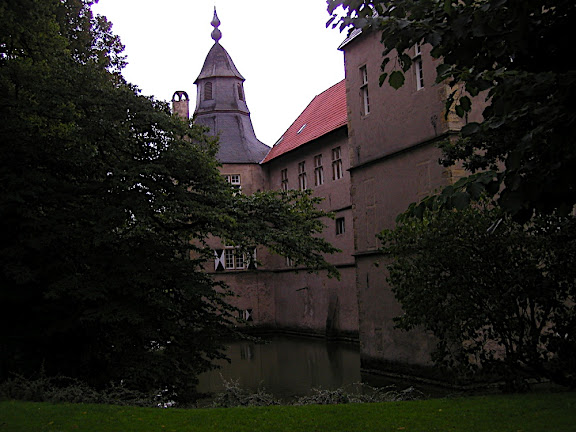 Lots of moated castles along the way. This is Schloss Westerwinkel. The weather continues cool and moist.
Lots of moated castles along the way. This is Schloss Westerwinkel. The weather continues cool and moist.
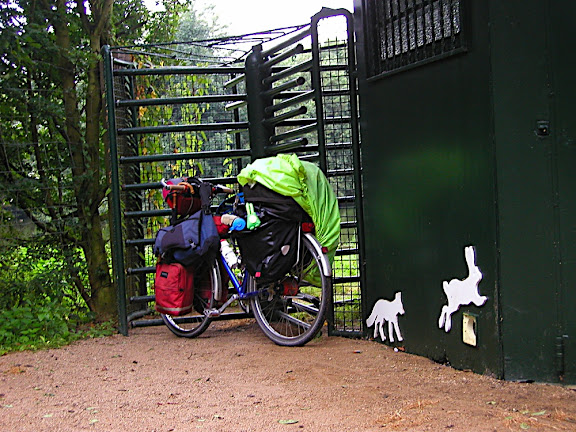 Over by Schloss Cappenberg.
Over by Schloss Cappenberg.
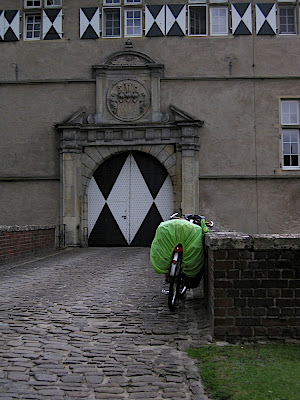 You can see that I still have the rain covers on my panniers.
You can see that I still have the rain covers on my panniers.
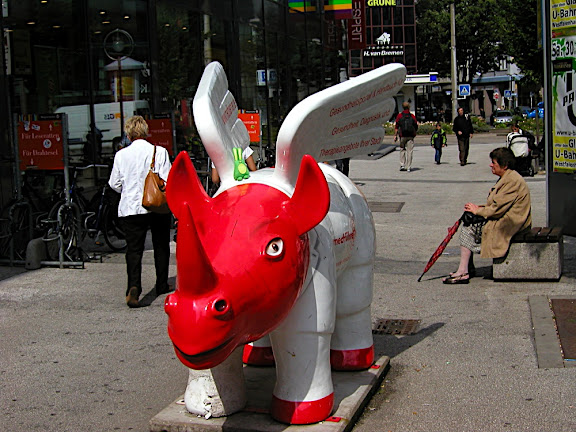 As you can see by the flying rhino, the rabbit and I have reached Dortmund.
As you can see by the flying rhino, the rabbit and I have reached Dortmund.
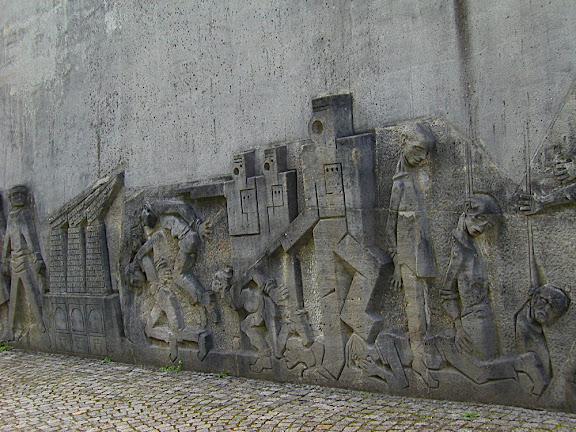 This is part of the Bittermark memorial, in the Dortmunder Stadtforst, where the fascists slaughtered a bunch of POWs and other folks.
This is part of the Bittermark memorial, in the Dortmunder Stadtforst, where the fascists slaughtered a bunch of POWs and other folks.
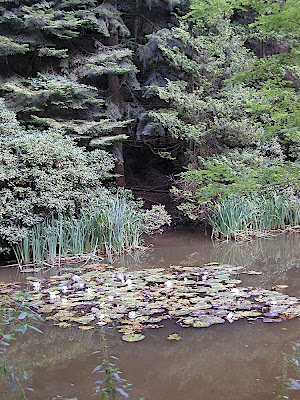 Waterlilies are much prettier than Nazis. Germany is a pretty country and is trying hard to strongly oppose nationalism, racism and nasty isms in general.
Waterlilies are much prettier than Nazis. Germany is a pretty country and is trying hard to strongly oppose nationalism, racism and nasty isms in general.
 Looking down at the Ruhr. While this area is very industrial, the Jacobsweg route goes through the nicest available forests and fields.
Looking down at the Ruhr. While this area is very industrial, the Jacobsweg route goes through the nicest available forests and fields.
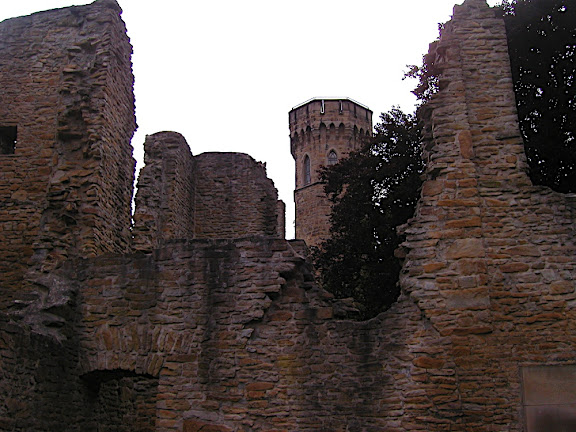 At the top of an evilly steep push up the Hohensyburg. Ruin of middle aged castle.
At the top of an evilly steep push up the Hohensyburg. Ruin of middle aged castle.
 Carrying my heavily loaded bike up and down the Hohensyburg path just about made a middle aged ruin of this boy. Cripes, this sucked. But this was the way the Jakobsweg went, and I wanted to stay on the official pilgrimage way. Why was that again?
Carrying my heavily loaded bike up and down the Hohensyburg path just about made a middle aged ruin of this boy. Cripes, this sucked. But this was the way the Jakobsweg went, and I wanted to stay on the official pilgrimage way. Why was that again?
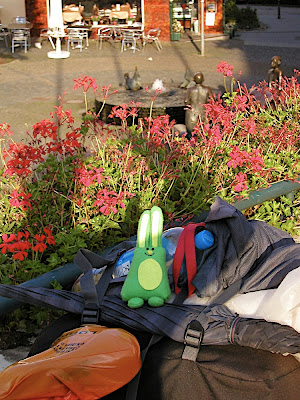 Pretty square in Herdecke, I think.
Pretty square in Herdecke, I think.
 I left behind the tent so I didn't have to worry about it being stolen. That was a stupid move. Here I have rigged up plastic sheets, tied to these logs and my bike, to sleep under. The rain has eased up, but not stopped. This is a rather settled area, so I had to push my bike to the top of the forested hills to camp. This is the top of the Gevelsberg.
I left behind the tent so I didn't have to worry about it being stolen. That was a stupid move. Here I have rigged up plastic sheets, tied to these logs and my bike, to sleep under. The rain has eased up, but not stopped. This is a rather settled area, so I had to push my bike to the top of the forested hills to camp. This is the top of the Gevelsberg.
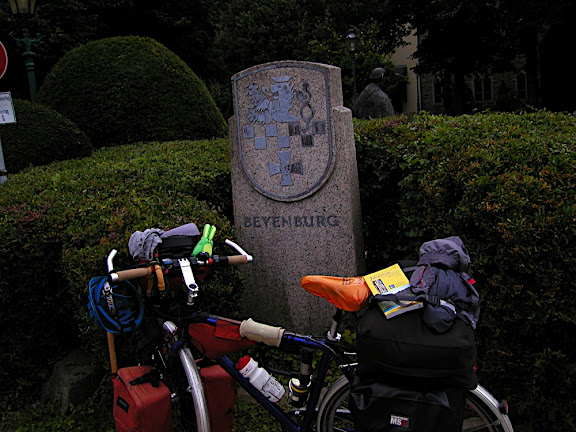 This stretch of the Jacobsweg ends here at the Wuppertal-Beyenberg, at the church of Mary Magdalene. I took a badly needed bath in the Wupper (stream), while some nice folks discreetly looked away and chatted with me about my trip.
This stretch of the Jacobsweg ends here at the Wuppertal-Beyenberg, at the church of Mary Magdalene. I took a badly needed bath in the Wupper (stream), while some nice folks discreetly looked away and chatted with me about my trip.
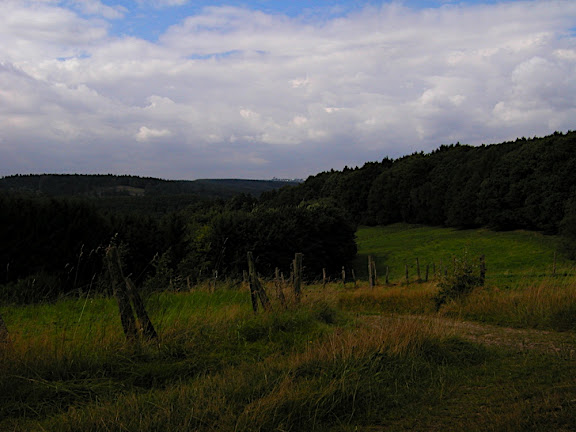 Up over the hills again. Mostly singletrack, sometimes dirt roads. Good thing I carry my own bread, cheese, chocolate and Pils.
Up over the hills again. Mostly singletrack, sometimes dirt roads. Good thing I carry my own bread, cheese, chocolate and Pils.
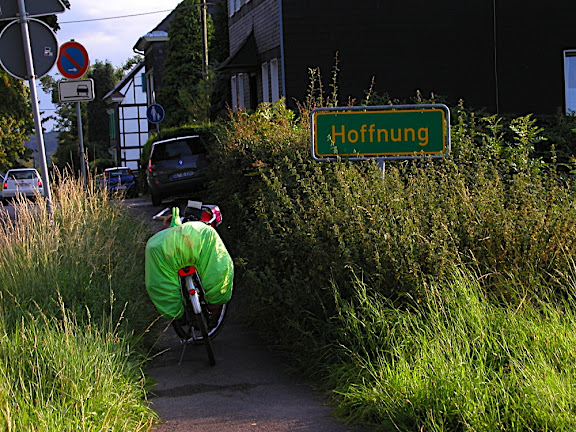 OK, so I am technically lost at this point, at least I can't find the Weg. I just did a big push along a horse path, through the mud and nettles, and finally happened upon a guy. I said something about "I sure hope I'm still on the Jakobsweg", and of course I wasn't. He directed me through the forest and meadows, across the stream, and to this road where I met two nice old ladies out Nordic Walking. I asked them the way to Odenthal, and they nicely mis-directed me. So I can verify that Hope (Hoffnung) is up a steep hill, in the wrong direction.
OK, so I am technically lost at this point, at least I can't find the Weg. I just did a big push along a horse path, through the mud and nettles, and finally happened upon a guy. I said something about "I sure hope I'm still on the Jakobsweg", and of course I wasn't. He directed me through the forest and meadows, across the stream, and to this road where I met two nice old ladies out Nordic Walking. I asked them the way to Odenthal, and they nicely mis-directed me. So I can verify that Hope (Hoffnung) is up a steep hill, in the wrong direction.
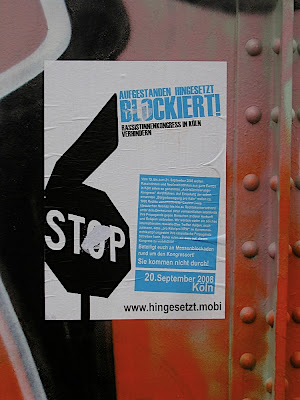 I just reached Koln! Crossing the Rhein, I came across this poster. The freaking neo-Nazis are having an anti-Muslim event. This poster is to mobilize the Antifa (anti-fascists) such as me. Gegen Nazis! No pasaran!
I just reached Koln! Crossing the Rhein, I came across this poster. The freaking neo-Nazis are having an anti-Muslim event. This poster is to mobilize the Antifa (anti-fascists) such as me. Gegen Nazis! No pasaran!
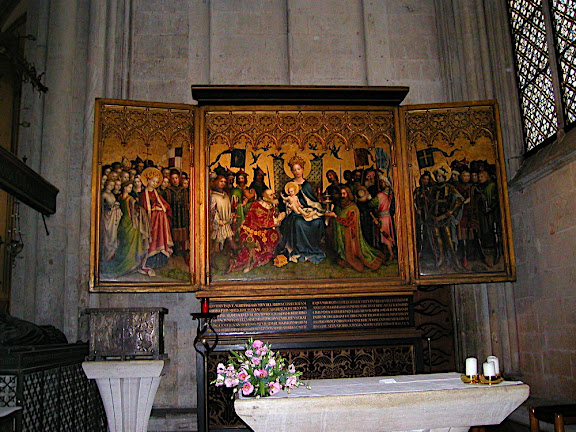 Koln, of course, is a major Pilgrimage city.
Koln, of course, is a major Pilgrimage city.

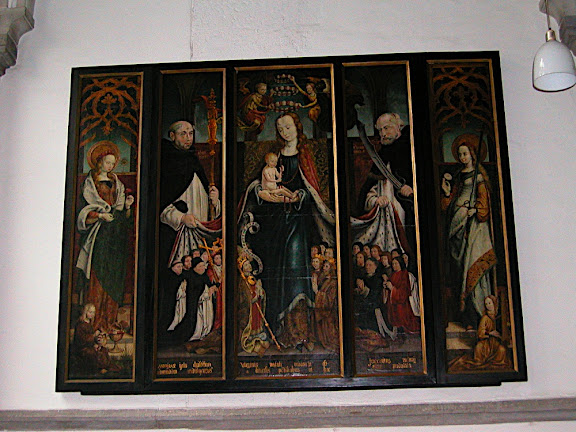 I like cheerful Mary art.
I like cheerful Mary art.
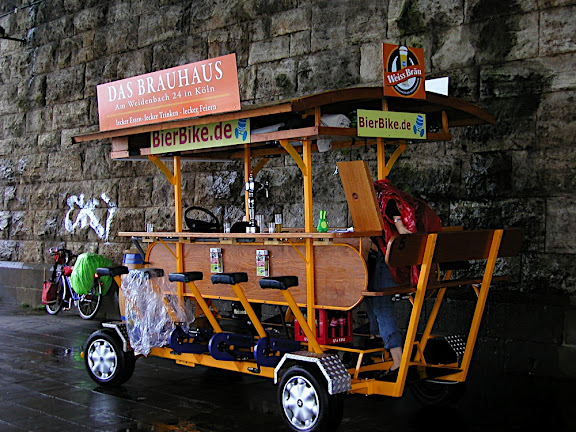 Down the Rhein! It is raining heavily as I ride from Koln to Bonn, but as I leave Koln I pass several BierBikes. That's a bar in the middle. You sit facing in, and pedal along. Singing. No helmet required.
Down the Rhein! It is raining heavily as I ride from Koln to Bonn, but as I leave Koln I pass several BierBikes. That's a bar in the middle. You sit facing in, and pedal along. Singing. No helmet required.
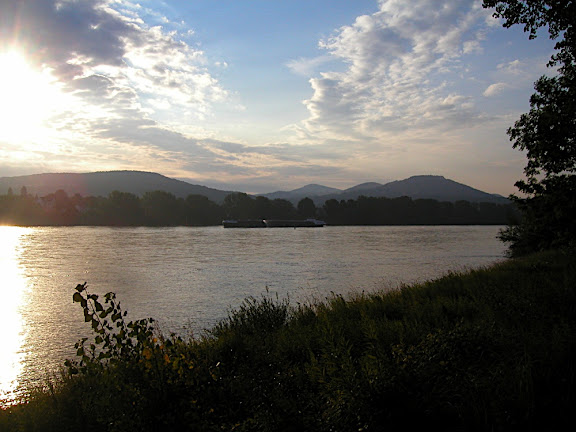 Even along the Rhein the sun comes out.
Even along the Rhein the sun comes out.
 If this doesn't look familiar, you have probably heard of the bridge at Remagen. It somehow didn't get destroyed, enabling the US 27th Armored Infantry Battalion to cross. Meanwhile, my Dad was already paralyzed from the assault on Anzio Beach in Italy, 1944. Fascists are not thought well of, in my family. We will oppose them everywhere, forever, under any name, in every way.
If this doesn't look familiar, you have probably heard of the bridge at Remagen. It somehow didn't get destroyed, enabling the US 27th Armored Infantry Battalion to cross. Meanwhile, my Dad was already paralyzed from the assault on Anzio Beach in Italy, 1944. Fascists are not thought well of, in my family. We will oppose them everywhere, forever, under any name, in every way.
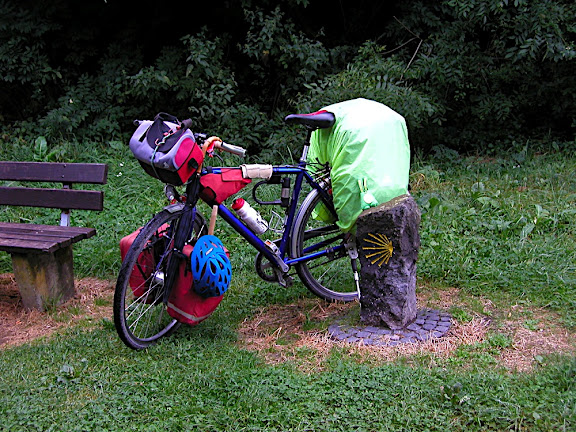 Back on the Jakobsweg, Rhein portion.
Back on the Jakobsweg, Rhein portion.
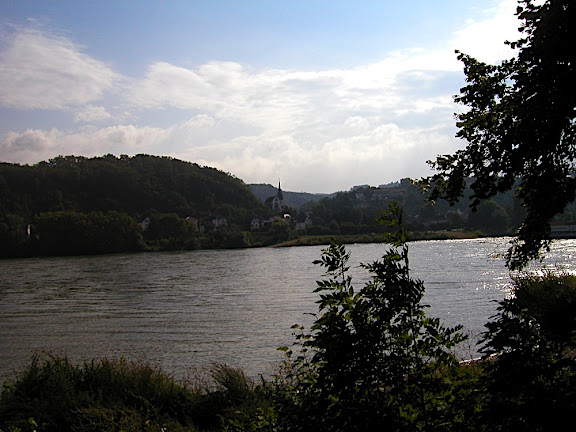 another Rhein river photo. No rain!
another Rhein river photo. No rain!
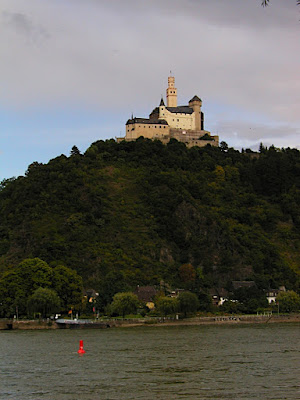 Obligatory castle shot.
Obligatory castle shot.
 ">
"> "
"
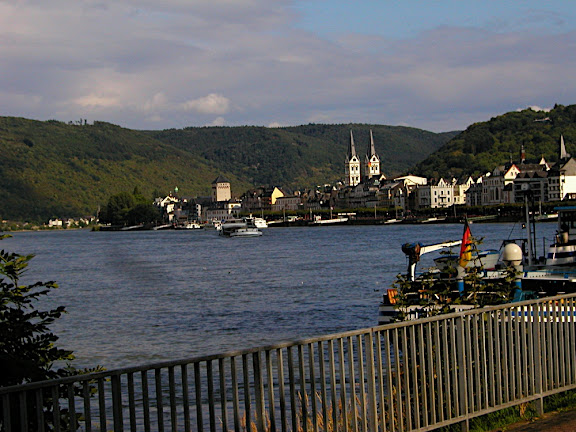 Nice churches, too, eh?
Nice churches, too, eh?
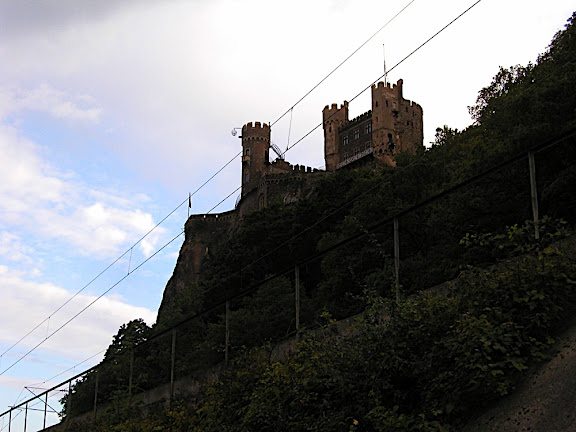 Back in the old days the folks up on this hill probably worked hard to subjugate and exploit my ancestors.
Back in the old days the folks up on this hill probably worked hard to subjugate and exploit my ancestors.
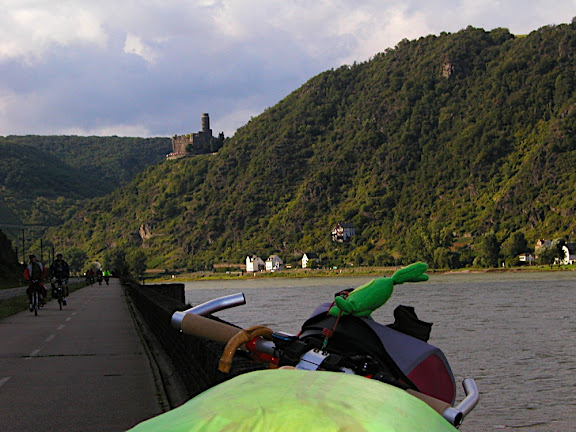 yep, the Rhein has been heavily fortified for a long time. I like it better now.
yep, the Rhein has been heavily fortified for a long time. I like it better now.
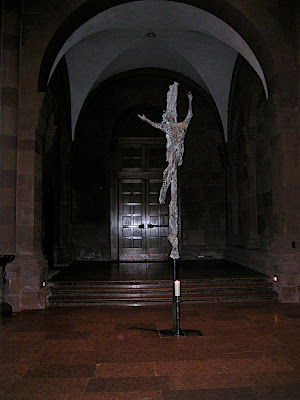 this is a nice resurrecting Jesus cross, from the Mainz cathedral. At this point I will keep heading south to Mannheim, where I will leave the Rhein and go along the Neckar to Heidelberg.
this is a nice resurrecting Jesus cross, from the Mainz cathedral. At this point I will keep heading south to Mannheim, where I will leave the Rhein and go along the Neckar to Heidelberg.
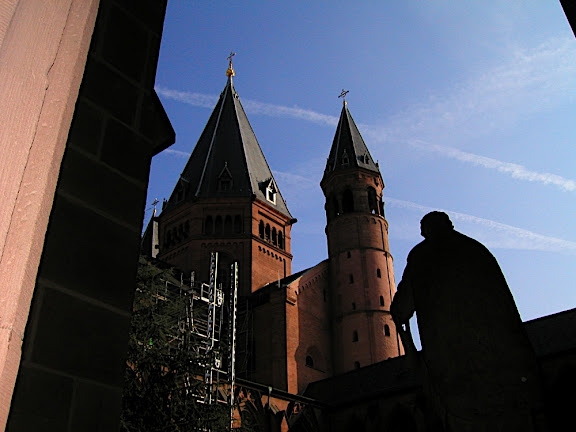 Outside of the Mainzer Dom. My front tire (they are tubeless) has been leaking badly for days, and I just put in a can of inflate-a-spare. Say a prayer for it!
Outside of the Mainzer Dom. My front tire (they are tubeless) has been leaking badly for days, and I just put in a can of inflate-a-spare. Say a prayer for it!
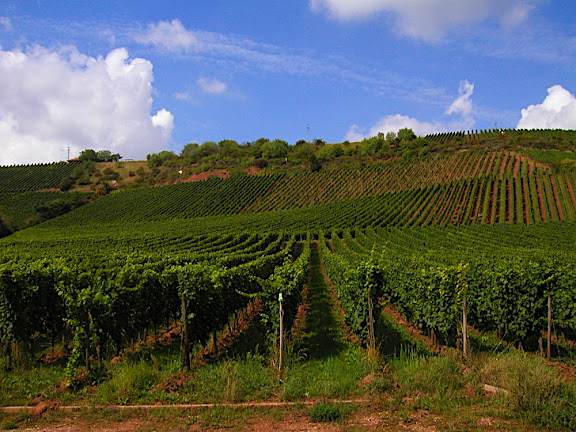 Vineyards. Note rabbit in foreground (on post).
Vineyards. Note rabbit in foreground (on post).
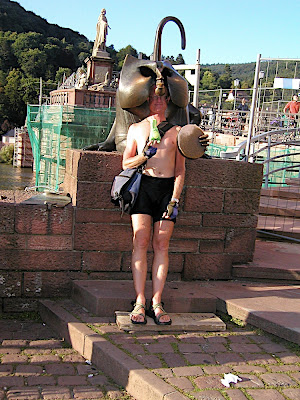 Ok, I'm in Heidelberg. Tourist shot. It is hot, and I need to slam a few Pils (for the carbohydrates) and keep heading south. I make it to Judy and Dave's house in Rauensberg as darkness falls. Days later than expected, but I have almost 2 days to visit before I have to catch the train back to Munster. This trip was over 700 km, including a great deal of walking and pushing. But it was still way faster than walking the whole way! Hopefully Bonnie will be with me as we continue the way toward Santiago. This trip was lonely without her, even with the faithful travel rabbit.
Ok, I'm in Heidelberg. Tourist shot. It is hot, and I need to slam a few Pils (for the carbohydrates) and keep heading south. I make it to Judy and Dave's house in Rauensberg as darkness falls. Days later than expected, but I have almost 2 days to visit before I have to catch the train back to Munster. This trip was over 700 km, including a great deal of walking and pushing. But it was still way faster than walking the whole way! Hopefully Bonnie will be with me as we continue the way toward Santiago. This trip was lonely without her, even with the faithful travel rabbit.
Monday, July 21, 2008
Summer 2008 Europe trip
Much travel. I (Richard) was in Trinidad for about 2 weeks, then flew to Dusseldorf via New York and via train to Muenster. After a whole 2 days we were back on the train to Dortmund with our bikes (which live here in Muenster) for the EasyJet to London Luton. At that point we were supposed to have a simple 30 mile ride to Teddington and the UK National Physical Laboratory. We spent several hours seemingly circling St. Albans but eventually broke free and made it to London proper. Unfortunately I lost Bonnie in London traffic. She turned right, I couldn't see her in the crowds, and after I kept on a kilometer or so I couldn't even find my way back (tried for an hour). So, no problem, just use the cell phone! Unfortunately, Bonnie had switched the chip in her phone and I didn't seem to have the new number. She also had all the maps. Fortunately, the natives spoke a language much like mine, so I queried them and found that they had no idea how to get anywhere at all. Fortunately some of the girls were quite attractive so it wasn't a complete waste. I finally found a petrol station, got directions to Teddington, and cycled there. The address of the Teddington Lodge was in my notebook, but it was a bit hard to find since it had no sign or building number. Eventually found the Lodge. Proprieter not there, nor Bonnie. Sat on stump, after a while a tenant came out and we phoned the proprieter. No reservation, it seems Bonnie hadn't confirmed it. Got a room anyway due to kindness of proprieter. Waited on street for an hour and Bonnie comes and I flag her down! She had lost her notebook on the way and had no address for the Lodge (which no one had heard of, of course).
We both gave seminars at the National Physical Laboratory, and they were received kindly. Bonnie ran some aerosol samples on their SIMS (Ian Gilmore has terrific facilities at NPL) and the data looks useful. Teddington is close to the Thames River and to the palace at Hampton Court, overall a pleasant area. After a week of work and excellent fish/chips/ale we rode into central London to spend Saturday at the splendid British Museum. Strongly recommended, particularly the Middle East sections. Rode back to the Lodge through the spacious and green deer parks of Richmond and Bushy Parks. Next day we left Teddington for Montpelier (France) via Gatwick Airport, which was the usual ghastly fiasco of little sleep the night before, ride to the airport in heavy traffic, dis-assembly and re-packing of bikes/luggage, difficulty in checking bicycles, security issues, etc etc. This theme occurs at every airport and so we will probably not be flying with bicycles again. Train, easy. Plane, bad.
Montpelier is a lovely city with excellent cycling infrastructure, a very attractive pedestrian-zone central area, and a great deal of wine. Our little room on the Rue Verdun was nice (in that the proprietors were very accommodating of our cycles) and so loud that I had to sleep with earplugs. During our week here I wandered around and Bonnie attended the Chemometrics conference. Her talk here was again well received. We watched the EuroCup 2008 final on the outdoor big-screen set up at the Place Comedie. Lots of Spanish fans and German fans cheering in a square in France. Maybe the world is getting better. Spain deservedly won despite Lehmann’s best keeping efforts.
Following the conference we headed along the coast on our cycling tour. The Mediterranean coast had lots of traffic (mostly well behaved) and was the anticipated sun and sand. Naturally we swam, sat on the beach, and completely ignored the topless bikini babes. Beziers had a beautiful church, but our bikes were slightly robbed. We lost Bonnie’s binoculars, axle nut wrench (which had significance), some gummi-bears and a watch. Roughly that night also our dinner was inedible due to some contamination of the cooking pot, either from soap or alcohol denaturant. The food was so bitter from whichever contamination that we couldn’t eat it, despite hunger and Bonnie’s cooking efforts. After a day or two we turned inland along the Midi Canal to Carcassone (well preserved medieval city). The canal path was a good overall choice of route, since while dirt and bumpy it was also shady and significantly cooler than the surrounding area. It also made it very easy to find campsites. The view of the medieval city was splendid; the interior a kitchy mess of tourist shops. At this point we realized that our travel rabbit was gone! Polly, the Polyester Bunny, had been kidnapped. She was no longer strapped happily to the top of Bonnie’s rear panniers. Saddened and rabbitless, we returned along the canal to Narbonne and continued down the coast toward Spain. Interestingly, as we crossed the border the signs did not all change to Spanish as anticipated. They were in Catalan! Some had Spanish also, but indeed we were in Catalunya and that was the prevailing tongue (and flag). Awkward, since that meant we didn’t have the language. To me it seemed Catalan was in between French and Spanish. I could figure out the written words, but couldn’t communicate. However, thanks to British/American/capitalist imperialism, lots of folks had some English and we muddled through fine.
While we had decided that we didn’t really need to do the Pyrenees on this trip, the coast road had plenty of climbing/pushing for Bonnie and her Baby Bikie. Once again we found the temperatures inland to be overly warm, so we tended to stay near the Med. as much as feasible. This also gave us beach showers (hooray for civilization) and seafood paella. We had one night of significant thunderstorm but fortunately found a site off the road and got the tent up in time. Lots of people drove up to honk at us, but at least we were dry! We made Barcelona at mid-afternoon and got to see the wonderful Sangrada Familia Church of Gaudi. We had done reasonably well for campsites until Barcelona, but here we slept uneasily the first night under a bridge. Next morning we rode back into the center and blessedly found a hostel, so we could take a hot shower and deposit our stuff in safety. We spent hours at the extraordinary Cathedral and wore ourselves out walking around Barcelona. We loved Barcelona and Catalunya and will definitely be back. The people were cycling friendly and nice, architecture impressive and inspiring, the mountains and sea and pines lovely, the food pleasing. Prices were not low but average Western Europe.
This years roughly 900 km trip included some travails, but was overall a merrie voyage. Cycling in southern France and Catalunya was a joy. Getting on the plane from Barcelona to Dortmund was miserable since our bikes couldn’t fit into the x-ray without removing the wheels, which we couldn’t do (recall the wrench was stolen way back in this story?), but the personnel at EasyJet in Barcelona were a wonderful help and eventually got us through security. The bikes seem to have come through the plane ride trips OK in their plastic bags, excepting a crushed Tubus rear carrier tube on mine. The rack does still work. The cargo people scuffed up our panniers something fierce. I feel fortunate that our gear mostly survived and dis-inclined to risk it again, especially with the misery involved in each air flight. Right now I am happy to be in our apartment in Muenster and not have to leave for a month! The weather has turned rather cool and wet, but we are here to work afterall.
We both gave seminars at the National Physical Laboratory, and they were received kindly. Bonnie ran some aerosol samples on their SIMS (Ian Gilmore has terrific facilities at NPL) and the data looks useful. Teddington is close to the Thames River and to the palace at Hampton Court, overall a pleasant area. After a week of work and excellent fish/chips/ale we rode into central London to spend Saturday at the splendid British Museum. Strongly recommended, particularly the Middle East sections. Rode back to the Lodge through the spacious and green deer parks of Richmond and Bushy Parks. Next day we left Teddington for Montpelier (France) via Gatwick Airport, which was the usual ghastly fiasco of little sleep the night before, ride to the airport in heavy traffic, dis-assembly and re-packing of bikes/luggage, difficulty in checking bicycles, security issues, etc etc. This theme occurs at every airport and so we will probably not be flying with bicycles again. Train, easy. Plane, bad.
Montpelier is a lovely city with excellent cycling infrastructure, a very attractive pedestrian-zone central area, and a great deal of wine. Our little room on the Rue Verdun was nice (in that the proprietors were very accommodating of our cycles) and so loud that I had to sleep with earplugs. During our week here I wandered around and Bonnie attended the Chemometrics conference. Her talk here was again well received. We watched the EuroCup 2008 final on the outdoor big-screen set up at the Place Comedie. Lots of Spanish fans and German fans cheering in a square in France. Maybe the world is getting better. Spain deservedly won despite Lehmann’s best keeping efforts.
Following the conference we headed along the coast on our cycling tour. The Mediterranean coast had lots of traffic (mostly well behaved) and was the anticipated sun and sand. Naturally we swam, sat on the beach, and completely ignored the topless bikini babes. Beziers had a beautiful church, but our bikes were slightly robbed. We lost Bonnie’s binoculars, axle nut wrench (which had significance), some gummi-bears and a watch. Roughly that night also our dinner was inedible due to some contamination of the cooking pot, either from soap or alcohol denaturant. The food was so bitter from whichever contamination that we couldn’t eat it, despite hunger and Bonnie’s cooking efforts. After a day or two we turned inland along the Midi Canal to Carcassone (well preserved medieval city). The canal path was a good overall choice of route, since while dirt and bumpy it was also shady and significantly cooler than the surrounding area. It also made it very easy to find campsites. The view of the medieval city was splendid; the interior a kitchy mess of tourist shops. At this point we realized that our travel rabbit was gone! Polly, the Polyester Bunny, had been kidnapped. She was no longer strapped happily to the top of Bonnie’s rear panniers. Saddened and rabbitless, we returned along the canal to Narbonne and continued down the coast toward Spain. Interestingly, as we crossed the border the signs did not all change to Spanish as anticipated. They were in Catalan! Some had Spanish also, but indeed we were in Catalunya and that was the prevailing tongue (and flag). Awkward, since that meant we didn’t have the language. To me it seemed Catalan was in between French and Spanish. I could figure out the written words, but couldn’t communicate. However, thanks to British/American/capitalist imperialism, lots of folks had some English and we muddled through fine.
While we had decided that we didn’t really need to do the Pyrenees on this trip, the coast road had plenty of climbing/pushing for Bonnie and her Baby Bikie. Once again we found the temperatures inland to be overly warm, so we tended to stay near the Med. as much as feasible. This also gave us beach showers (hooray for civilization) and seafood paella. We had one night of significant thunderstorm but fortunately found a site off the road and got the tent up in time. Lots of people drove up to honk at us, but at least we were dry! We made Barcelona at mid-afternoon and got to see the wonderful Sangrada Familia Church of Gaudi. We had done reasonably well for campsites until Barcelona, but here we slept uneasily the first night under a bridge. Next morning we rode back into the center and blessedly found a hostel, so we could take a hot shower and deposit our stuff in safety. We spent hours at the extraordinary Cathedral and wore ourselves out walking around Barcelona. We loved Barcelona and Catalunya and will definitely be back. The people were cycling friendly and nice, architecture impressive and inspiring, the mountains and sea and pines lovely, the food pleasing. Prices were not low but average Western Europe.
This years roughly 900 km trip included some travails, but was overall a merrie voyage. Cycling in southern France and Catalunya was a joy. Getting on the plane from Barcelona to Dortmund was miserable since our bikes couldn’t fit into the x-ray without removing the wheels, which we couldn’t do (recall the wrench was stolen way back in this story?), but the personnel at EasyJet in Barcelona were a wonderful help and eventually got us through security. The bikes seem to have come through the plane ride trips OK in their plastic bags, excepting a crushed Tubus rear carrier tube on mine. The rack does still work. The cargo people scuffed up our panniers something fierce. I feel fortunate that our gear mostly survived and dis-inclined to risk it again, especially with the misery involved in each air flight. Right now I am happy to be in our apartment in Muenster and not have to leave for a month! The weather has turned rather cool and wet, but we are here to work afterall.
Sunday, July 20, 2008
Moving Woes
Sorry that I (Bonnie) haven’t updated the blog in months but life has been very hectic. Those of you who have moved in the recent past will likely remember that moving is at best an unpleasant task. Multiply that misery by some very large number and you will get the agony of moving your household and laboratory overseas to a small island developing state (SIDS).
I had an NIH site visit in Seattle in late February which corresponded with spring break at UWI, so I arranged to spend several days in Salt Lake with Rich sorting and packing our stuff. The task was particularly painful because stuff had to be sorted into stuff we planned to store, stuff we needed to take, stuff to get rid of and stuff we needed to take but that Rich needed until he moved at the end of May. This was made all the more difficult by the fact that we had no clear idea how much stuff would fit in a 20 foot shipping container.
Back at the beginning of the year, I contracted Global Ocean Freight to move a 20 foot container loaded with our stuff to Trinidad. If ever you should need to move something overseas, DO NOT use Global Ocean Freight. They screwed up every single aspect of the shipment. Under the contract, they were supposed to deliver the container to us on March 1 while I was in the states for an NIH site visit. Since we were told we would have only 2 hours to load the container, we spent the week prior to March 1 trying to get them to nail down a specific time when the container would arrive at our condo. No luck. Finally on Friday afternoon (Feb. 29), they told us that they wouldn’t be able to get a container to us until the end of the following week. (insert appropriate string of curses). Of course, I had to fly back to Trinidad on March 2 so I could teach my classes on March 3 which meant Rich would be left to do the job without me. Even after a great deal of negotiation about their breach of contract, we still couldn’t actually pin them down to a delivery time but they did agree that we (or rather Rich) could have a full day rather than just 2 hours to load the container.
To make matters worse, both of us had picked up the nasty stomach bug that was going around Salt Lake at the time. Rich spent the rest of the week trying to not collapse completely while finishing the packing and teaching his classes. Meanwhile the shipping company still wouldn’t give us the slightest clue as to when the container would arrive. Friday afternoon, Rich left work early because he was so sick so he happened to be home in the middle of the afternoon when a truck driver called saying they were on I-15 and would arrive any minute. So the truck showed up and left the container in the Condo driveway, still on the semitrailer (5 ft off the ground) and without a ramp. As soon as he left, the Condo manager showed up and yelled at Rich because we had not properly informed them of the time that the container would arrive. He was quite insistent that the container had to be moved immediately (which was physically impossible since the truck had left) or he would call the police. Luckily my Father showed up just about this time and managed to reason with the Condo manager. Fortunately for Rich, my Dad was able to arrange for a bunch of family members to come help with the loading, which required hoisting everything up the 5 ft. Unfortunately, they could only do it Friday night and Rich was sick so the packing wasn’t finished which didn’t make anything easier.
It turned out that a 20 foot container holds about twice as much as we’d estimated so after all the stuff we’d originally planned to take was packed, Rich and I talked it over on the phone and decided to bring the rest of the furniture. That meant that everything in the container had to be rearranged once again and a bunch of stuff we’d sent off to storage had to be retrieved. Rather a nightmarish weekend for a sick guy. Finally, on the 11th of March they came and picked up the container only 10 days behind schedule. Not so bad for a SIDS, but this was still on the USA end, a supposed developed country.
Fast forward 20 days to the beginning of April. I’d been busy working with the Trinidad subcontractor to Global Ocean Freight to make various customs arrangements, which included things like getting a license to import a freezer and a sea kayak. So we were all ready for the container to arrive before its scheduled date on the 2nd of April. I got a call from the shipping company late on a Friday afternoon (March 29) saying the shipment had arrived. False alarm. The ship had arrived but my container wasn’t on it. A mad search ensued to locate the container, which was initially thought to have been left in the Bahamas but was ultimately located in Dominica. The container gets booked on a new ship scheduled to arrive in Trinidad on April 21. This is cutting things a bit close since I have plane tickets to attend an advisory board meeting in Seattle on April 30 and I have to be there in person to clear the shipment through customs. The Trinidad shippers did a fantastic job expediting everything so that we can get the container rapidly cleared through customs but there is still one problem. Global Ocean Freight hasn’t paid the freighter so they won’t release the container. Both the Trini shippers and I talk to them several times and are assured that the bill has been paid and the container will be released before the ship reaches port. The ship comes in Sunday and Monday morning it still hasn’t been released. I make panicked phone calls to Florida but since it’s a Jewish holiday, no one at Global Ocean Freight can help. First thing Tuesday morning, I’m back on the phone to GOF, and the same woman who told me the previous Thursday that the bill had been paid and the container would definitely be released before it arrived in port, tells me she had just paid the bill and it will take 72 hours for the payment to clear before my container gets released (insert appropriate string of curse words). I point out to the woman that if I can’t get the container before I leave, it will cost me $50 US per day. She tells me tough luck. This continues through the week until late Friday afternoon when the ship finally releases the container. At that point, customs set an appointment for me to clear the shipment on the following Wednesday. AARRRRRGG, I’m scheduled to be on a plane to the USA at 7 AM that morning and it will cost me over $1000 to change the ticket. Early Monday morning, I accompany a representative of the Trini shipping company to customs and they agree to move my appointment to Tuesday morning. The plan is to get it cleared through customs in the morning and then deliver it that afternoon when I’ve arranged a group of people I know from church to help unload.
Tuesday morning I arrive at customs at 9 AM but the container isn’t there. A truck has to haul it around the fence from the port to the customs office. This was supposed to happen Monday afternoon but customs had closed before the trucking company got there. About 10 AM, the truck comes to the port to get the container but there is a long line waiting for the crane so my container doesn’t get loaded on the truck before 11 AM, when the port takes its 1 hour lunch break. About 5 minutes after noon the truck carrying my container pulls into customs but now customs is taking their 1 hour lunch break. Shortly after one, a woman from customs escorts me and the rep. from the Trini shipping company out to the container to check the seal. BIG PROBLEM. Global Ocean Freight has incorrectly recorded the seal number on the paper work; they left out two digits. BIG PROBLEM!!! So the rep. from the Trini shipping company literally runs across town and persuades some upper level person in customs that this was a clerical error and they agree to let me have the stuff. So now its nearly 2:30 and they start unloading everything from the 20 foot container and then a customs inspector and I go around while he randomly opens boxes to see what’s in them. Finally, they clear my shipment at shortly after 3 PM. They are then supposed to repack the container and deliver it to me. I rush off since I’ve got people from church meeting at my house at 4 pm. When I’m about half way back to St. Augustine, I get a call on my cell phone saying that customs closed before they had reloaded the container and locked all my stuff inside. No chance or recovering it before my flight the next morning. (Insert appropriate string of curses).
In the next hour, the Trini shipping company arranges for some professionals to unload the container the following evening and my neighbor agrees to open my flat and sign for the shipment. So the next morning I hop on a plane for Salt Lake City with my stuff still locked in customs. Luckily, my good Trini neighbor Annabelle and the local shippers managed it all with only one small hitch. The truck carrying the container was too tall to fit under the electrical wires above the gate to our complex. It hit the wires and according to the neighborhood kids there were sparks flying. Then they had to get a smaller truck to shuttle stuff between the gate and our flat. Luckily, I didn’t hear anything about this until the neighborhood kids regaled me with the tale. When I called from the states, Annabelle just said everything had arrived and was safely stowed in my flat.
Two weeks later when I returned from the states, the first floor of my flat was packed to the ceiling with boxes. Some wonderful friends from church came over the next couple of days and help me carry beds upstairs and unpack most everything. By the time Rich arrived on June 1st, there were only a half dozen or so boxes left to unpack. Amazingly, only a couple of things got broken and they were largely reparable. The glass from only of larger pictures got broken and it was quite a hassle cleaning it up without cutting the rest of the pictures but Rich managed.
The day after Rich arrived, we had our first guests, a friend and student who we’ve worked with in Münster Germany for the past several years and his lovely girl friend. Between entertaining guests, trying to get Rich’s VISA (another torturous tale) and various obligations at UWI the next two weeks raced by and now we are on study leave in Europe for the next two months. We barely managed to recover Rich’s passport and VISA from immigration hours before our plane departed.
It was a hellacious three months, but we are finally moved in with legal VISAs and everything. We'll post some stuff on our Europe trip soon.
Bye for Now.
I had an NIH site visit in Seattle in late February which corresponded with spring break at UWI, so I arranged to spend several days in Salt Lake with Rich sorting and packing our stuff. The task was particularly painful because stuff had to be sorted into stuff we planned to store, stuff we needed to take, stuff to get rid of and stuff we needed to take but that Rich needed until he moved at the end of May. This was made all the more difficult by the fact that we had no clear idea how much stuff would fit in a 20 foot shipping container.
Back at the beginning of the year, I contracted Global Ocean Freight to move a 20 foot container loaded with our stuff to Trinidad. If ever you should need to move something overseas, DO NOT use Global Ocean Freight. They screwed up every single aspect of the shipment. Under the contract, they were supposed to deliver the container to us on March 1 while I was in the states for an NIH site visit. Since we were told we would have only 2 hours to load the container, we spent the week prior to March 1 trying to get them to nail down a specific time when the container would arrive at our condo. No luck. Finally on Friday afternoon (Feb. 29), they told us that they wouldn’t be able to get a container to us until the end of the following week. (insert appropriate string of curses). Of course, I had to fly back to Trinidad on March 2 so I could teach my classes on March 3 which meant Rich would be left to do the job without me. Even after a great deal of negotiation about their breach of contract, we still couldn’t actually pin them down to a delivery time but they did agree that we (or rather Rich) could have a full day rather than just 2 hours to load the container.
To make matters worse, both of us had picked up the nasty stomach bug that was going around Salt Lake at the time. Rich spent the rest of the week trying to not collapse completely while finishing the packing and teaching his classes. Meanwhile the shipping company still wouldn’t give us the slightest clue as to when the container would arrive. Friday afternoon, Rich left work early because he was so sick so he happened to be home in the middle of the afternoon when a truck driver called saying they were on I-15 and would arrive any minute. So the truck showed up and left the container in the Condo driveway, still on the semitrailer (5 ft off the ground) and without a ramp. As soon as he left, the Condo manager showed up and yelled at Rich because we had not properly informed them of the time that the container would arrive. He was quite insistent that the container had to be moved immediately (which was physically impossible since the truck had left) or he would call the police. Luckily my Father showed up just about this time and managed to reason with the Condo manager. Fortunately for Rich, my Dad was able to arrange for a bunch of family members to come help with the loading, which required hoisting everything up the 5 ft. Unfortunately, they could only do it Friday night and Rich was sick so the packing wasn’t finished which didn’t make anything easier.
It turned out that a 20 foot container holds about twice as much as we’d estimated so after all the stuff we’d originally planned to take was packed, Rich and I talked it over on the phone and decided to bring the rest of the furniture. That meant that everything in the container had to be rearranged once again and a bunch of stuff we’d sent off to storage had to be retrieved. Rather a nightmarish weekend for a sick guy. Finally, on the 11th of March they came and picked up the container only 10 days behind schedule. Not so bad for a SIDS, but this was still on the USA end, a supposed developed country.
Fast forward 20 days to the beginning of April. I’d been busy working with the Trinidad subcontractor to Global Ocean Freight to make various customs arrangements, which included things like getting a license to import a freezer and a sea kayak. So we were all ready for the container to arrive before its scheduled date on the 2nd of April. I got a call from the shipping company late on a Friday afternoon (March 29) saying the shipment had arrived. False alarm. The ship had arrived but my container wasn’t on it. A mad search ensued to locate the container, which was initially thought to have been left in the Bahamas but was ultimately located in Dominica. The container gets booked on a new ship scheduled to arrive in Trinidad on April 21. This is cutting things a bit close since I have plane tickets to attend an advisory board meeting in Seattle on April 30 and I have to be there in person to clear the shipment through customs. The Trinidad shippers did a fantastic job expediting everything so that we can get the container rapidly cleared through customs but there is still one problem. Global Ocean Freight hasn’t paid the freighter so they won’t release the container. Both the Trini shippers and I talk to them several times and are assured that the bill has been paid and the container will be released before the ship reaches port. The ship comes in Sunday and Monday morning it still hasn’t been released. I make panicked phone calls to Florida but since it’s a Jewish holiday, no one at Global Ocean Freight can help. First thing Tuesday morning, I’m back on the phone to GOF, and the same woman who told me the previous Thursday that the bill had been paid and the container would definitely be released before it arrived in port, tells me she had just paid the bill and it will take 72 hours for the payment to clear before my container gets released (insert appropriate string of curse words). I point out to the woman that if I can’t get the container before I leave, it will cost me $50 US per day. She tells me tough luck. This continues through the week until late Friday afternoon when the ship finally releases the container. At that point, customs set an appointment for me to clear the shipment on the following Wednesday. AARRRRRGG, I’m scheduled to be on a plane to the USA at 7 AM that morning and it will cost me over $1000 to change the ticket. Early Monday morning, I accompany a representative of the Trini shipping company to customs and they agree to move my appointment to Tuesday morning. The plan is to get it cleared through customs in the morning and then deliver it that afternoon when I’ve arranged a group of people I know from church to help unload.
Tuesday morning I arrive at customs at 9 AM but the container isn’t there. A truck has to haul it around the fence from the port to the customs office. This was supposed to happen Monday afternoon but customs had closed before the trucking company got there. About 10 AM, the truck comes to the port to get the container but there is a long line waiting for the crane so my container doesn’t get loaded on the truck before 11 AM, when the port takes its 1 hour lunch break. About 5 minutes after noon the truck carrying my container pulls into customs but now customs is taking their 1 hour lunch break. Shortly after one, a woman from customs escorts me and the rep. from the Trini shipping company out to the container to check the seal. BIG PROBLEM. Global Ocean Freight has incorrectly recorded the seal number on the paper work; they left out two digits. BIG PROBLEM!!! So the rep. from the Trini shipping company literally runs across town and persuades some upper level person in customs that this was a clerical error and they agree to let me have the stuff. So now its nearly 2:30 and they start unloading everything from the 20 foot container and then a customs inspector and I go around while he randomly opens boxes to see what’s in them. Finally, they clear my shipment at shortly after 3 PM. They are then supposed to repack the container and deliver it to me. I rush off since I’ve got people from church meeting at my house at 4 pm. When I’m about half way back to St. Augustine, I get a call on my cell phone saying that customs closed before they had reloaded the container and locked all my stuff inside. No chance or recovering it before my flight the next morning. (Insert appropriate string of curses).
In the next hour, the Trini shipping company arranges for some professionals to unload the container the following evening and my neighbor agrees to open my flat and sign for the shipment. So the next morning I hop on a plane for Salt Lake City with my stuff still locked in customs. Luckily, my good Trini neighbor Annabelle and the local shippers managed it all with only one small hitch. The truck carrying the container was too tall to fit under the electrical wires above the gate to our complex. It hit the wires and according to the neighborhood kids there were sparks flying. Then they had to get a smaller truck to shuttle stuff between the gate and our flat. Luckily, I didn’t hear anything about this until the neighborhood kids regaled me with the tale. When I called from the states, Annabelle just said everything had arrived and was safely stowed in my flat.
Two weeks later when I returned from the states, the first floor of my flat was packed to the ceiling with boxes. Some wonderful friends from church came over the next couple of days and help me carry beds upstairs and unpack most everything. By the time Rich arrived on June 1st, there were only a half dozen or so boxes left to unpack. Amazingly, only a couple of things got broken and they were largely reparable. The glass from only of larger pictures got broken and it was quite a hassle cleaning it up without cutting the rest of the pictures but Rich managed.
The day after Rich arrived, we had our first guests, a friend and student who we’ve worked with in Münster Germany for the past several years and his lovely girl friend. Between entertaining guests, trying to get Rich’s VISA (another torturous tale) and various obligations at UWI the next two weeks raced by and now we are on study leave in Europe for the next two months. We barely managed to recover Rich’s passport and VISA from immigration hours before our plane departed.
It was a hellacious three months, but we are finally moved in with legal VISAs and everything. We'll post some stuff on our Europe trip soon.
Bye for Now.
Saturday, April 5, 2008
Easter Weekend

UWI was closed on Good Friday so Rich and I took the opportunity to go out and explore Trinidad’s north east peninsula. There were high seas and waves large enough to flood some of the buildings along the coast so we didn’t do any swimming in the ocean or snorkeling on this trip but we did see some beautiful beaches and got in two lovely hikes in the rain forest. As with most hiking and camping tales, this one is best told in pictures so take a good look at the slide show. To see a bigger version, double click on the slides or go to
We got up early friday morning and packed up the car with food, clothes and hiking gear and head in the direction of Matura where we’d seen the turtles Tuesday night. Our first stop was at Salybia, a few miles north of Matura. There is a resort on the beach there where I am planning to hold a small conference so we took the opportunity to tour the resort. It is indeed a lovely secluded spot. We also walked along the coast for a bit. There is public beach with lifeguards neighboring the resort at the mouth of the Rio Seco river. As expected, the spot was fairly popular on a holiday weekend but because of the high seas the lifeguards had shut down swimming on the beach and people had to content themselves with swimming in the Rio Seco river.
Across the road were trails into the Matura National park which promised lush tropical forest. We took a short trail (~ 2 mile each way) to the Rio Seco water fall. The trail was easy to find and wound through thick tropical forest. There are supposed to be howler monkeys in this area, but they were all hiding from us. The water fall itself (see pictures) is about 20 feet high and plunges into a perfect swimming hole. As expect, this was a popular spot on a holiday weekend. When we arrived there were maybe 2 dozen people at the pool swimming, eating lunch and trying to catch crawfish in the stream below the pool. It seems that most of them belonged to one big group so when they left it was much less crowded. We enjoyed a dip in the pool and lunch in view of the falls while listening to birds and other unidentified forest creatures.
That night we camped by the lighthouse at Galleria Point, the eastern most tip of Trinidad. From the point we could see Tobago in the distance. We enjoyed watching the pelicans fish as the waves rolled in and the sunset. There is a very interesting sea spout at Galeria Point. When big waves come in, water sprays up from a dozen or so small holes in the rocky point. Because of the high seas we enjoyed frequent bursts from the spouts. For dinner we had a green coconut we found along the way along with the cornbread, cheese, bananas and mangos.
Saturday we drove out to Matelot where the coastal road ends. From that point there is a roughly 25 mile trail connecting to the road from the west. We estimate that we hiked rough 7 miles in along this trail (14 round trip) where we saw lush forest, beautiful flowers, rivers and streams and an occasional glimpse of the coast line through the trees. Along the trail we came across several of the trees we’d learned to identify on Monos Island even though this was a much wetter region. Cocoa was once raised in the area and so we saw quite a few Cocoa trees. Cocoa is commonly grown with oranges which provide needed shade for the smaller cocoa plants. We passed several orange trees, one of which had just dropped a perfectly ripe and beautiful orange in our way (yum).
Since I want you all to come and visit, I’m not going to tell you about bad roads, getting the car stuck in the mud, the deadly poisonous snake, the stinging ants, or the chiggers. Come any way. Its beautiful. We had fun and so will you.
Subscribe to:
Posts (Atom)



